Berlin
Berlin is Germany's capital and co-extensive with the Land of Berlin, one of the 16 federal states that make up the Federal Republic of Germany. With a population of 3.5 million (4.5 million if adjacent suburbs across the state line in Brandenburg are counted), Berlin is Germany's biggest city, but the Ruhr area arguably has a bigger metro area population. The focus on and dominance of Berlin as a capital is and has historically been far weaker than that of London, Paris or Madrid, not least because of the federal nature of Germany and the havoc partition wreaked on the city
- For other places with the same name, see Berlin (disambiguation).

Berlin is unusual among European capitals in many respects and the four decades of partition - 28 years of them being physically separated by a wall - have also left traces. Barely a fishing village in the 18th century, Berlin grew to be one of the most important and biggest cities in the world by the 1920s, only to lose much of its importance and historic architecture as a result of World War II and German partition. The heart of old Prussia and a focal point of the Cold War, Berlin today is coming into its own again as a cosmopolitan capital of one of Europe's wealthiest nations. "Arm aber sexy" (poor but sexy) as a former mayor would have it, Berlin attracts young people, students and a creative bohème like few other cities in the world. With architectural heritage from Prussian monarchism, Nazism, East German communism and Potsdamer Platz, filled with 1990s and 2000s style glass palaces after having been a "blank canvas" due to the wall, Berlin's architecture is as varied as its neighbourhoods and its people. And due to its long history as a cosmopolitan capital (first of Prussia and later of Germany) it has attracted immigrants from all over the world for more than three hundred years now. It should thus be no surprise that immigrants past and present continue to leave a distinctive mark on the city.
Berlin is a world city of culture, politics, media and science. Its economy is based on high-tech firms and the service sector, a diverse range of creative industries, research facilities, media corporations. Significant industries also include IT, biotechnology, construction and electronics. Berlin is home to world-renowned universities, orchestras, museums, and entertainment venues, and is host to many sporting events. Its Zoological Garden is the most visited zoo in Europe and one of the most popular worldwide. With the world's oldest large-scale movie studio complex in nearby Babelsberg (Potsdam), Berlin is an increasingly popular location for international film productions. The city is well known for its festivals, nightlife, contemporary arts and a very high quality of living.
Districts
Berlin can be seen as a cluster of centres. Berlin has many boroughs (Bezirke), and each borough is composed of several localities (Kiez or Viertel) — each of these boroughs and localities have their unique style. Some boroughs of Berlin are more worthy of a visitor's attention than others. Berlin used to be divided into 23 boroughs, and these boroughs are used in Wikivoyage as they remain foremost in popular conceptions of the city and are useful for visitors to know. In January 2001, the number of boroughs was reduced from 23 to 12 for administrative purposes - mostly by merging old boroughs - sometimes across what was the inner-Berlin border. The boroughs can roughly be grouped into eight districts:
| Mitte (Mitte, Tiergarten) The "heart" of Berlin, once the centre of Berlin ("Mitte" could be translated as "centre"), then the nucleus of East Berlin and now coming into its own once more as the focal point of reunified Berlin. As well as many historically important sights there are also abundant cafés, restaurants, museums, galleries, and clubs in the district. |
| City West (Charlottenburg-Wilmersdorf, Schöneberg, Friedenau, Moabit, Hansaviertel) This used to be the urban heart of West Berlin with Kurfürstendamm (Ku'damm) and Trauenzienstraße still major shopping areas. While the party has since moved east, there are great restaurants and hotels as well as the Olympic stadium and Schloss Charlottenburg. |
| East Central (Friedrichshain, Kreuzberg, Prenzlauer Berg, Wedding) Made up of historically diverse neighbourhoods, Kreuzberg was in the West but "encircled" by the wall and drew leftists, cheapskates and malcontents, including a large squatter scene that frequently clashed with police, Friedrichshain likewise had squatters after reunification while "Prenzlberg" was a much more laid back residential neighbourhood. Today all those areas are gentrifying or already gentrified but there are still numerous cafes, clubs bars and Spätis, a kind of corner shop with late opening hours, typically specialised in the sale of alcohol and tobacco. |
| Reinickendorf and Spandau (Spandau, Reinickendorf) Spandau and Reinickendorf are beautiful old towns, which feel much more spacious than the inner city. At times they can feel a world apart from "Berlin proper". If you ask the average Berliner - and even many Spandauers - they'll tell you Spandau isn't "actually Berlin". Even the city's public transport provider BVG likes to make jokes along those lines. |
| East (Lichtenberg, Hohenschönhausen, Marzahn, Hellersdorf, Weißensee, Pankow) The museum at the site of the 1945 surrender to the Soviet army is of interest, as is the former Stasi prison, an essential visit for anyone interested in East German history. Marzahn-Hellersdorf's reputation for being a vast collection of dull high-rise apartment blocks is undeserved because it is the home of the "Gardens of the World", a large park where you can explore various ethnic styles of garden design. |
| Steglitz-Zehlendorf (Steglitz, Zehlendorf) The Southwest corner of Berlin, a rather bourgeois and relatively sparsely populated area with easy access to Potsdam. |
| Tempelhof and Neukölln (Tempelhof, Neukölln) The rapidly gentrifying northern parts of Neukölln now seamlessly pass over into Berlin/East Central and Tempelhof is still known as the site of "the mother of all airports" (now a park). |
| Treptow-Köpenick (Treptow, Köpenick) The southeastern corner, famous for the Hauptmann von Köpenick. |
Understand
History
The beginnings
The area was most likely first settled by Slavs before German-speaking immigrants arrived in the 11th and 12th centuries. The earliest evidence of settlements in the area of what is now Berlin are a wooden rod dated from approximately 1192 and remains of wooden houses dated to 1174 which were found in a 2012 excavation in Berlin Mitte. The first written records of towns in the area of present-day Berlin date from the late 12th century. Spandau is first mentioned in 1197 and Köpenick in 1209, although these areas did not become part of Berlin until 1920 (see below). The nucleus of Berlin were two towns: Berlin (now known as the Nikolaiviertel close to Alexanderplatz), which began as a Slavic town, and Cölln, which was Germanic in origin, which included what has today become the Museum Island.
The area became known as Berlin-Cölln and was a residence for the electors of Brandenburg but it remained relatively small. Roughly half of Berlin's inhabitants perished as a result of the Thirty Years' War (1618-1648). The war - which also devastated other Hohenzollern domains - led to a signature Hohenzollern policy of allowing and even encouraging religious refugees to immigrate to the area. The policy was first promulgated by "great elector" Frederic William (Friedrich Wilhelm, reigned 1640-1688) who also consolidated the trend of ruling Prussians to be called Friedrich, Wilhelm or both, which lasted all the way to the last German Kaiser Wilhelm II, who was forced to abdicate in 1918.
Berlin became the capital of Prussia in 1701 but Potsdam remained a symbol for Hohenzollern rule into Weimar times. In 1710 several independent towns were merged into Berlin, helping to give Berlin a polycentric layout that endures to this day. The Prussian leaders of the 18th century were known for their "enlightened despotism" and an amount of religious toleration far beyond that found in other parts of Europe at the time. Those policies benefited all of Brandenburg/Prussia but they had their strongest impact on Berlin, even though the Prussian residence remained in Potsdam for the most part.
Kaiserreich and Weimar Republic
The German Reich (Empire) was formed in 1871 under Prussian dominance and Berlin became the capital of this newly united Germany, quickly growing both due to its administrative role and its role as a centre of industry. By 1877 Berlin had more than one million inhabitants, and by 1900 the city had a population of 1.9 million.
Even though the revolution that deposed the Kaiser had broken out among discontent sailors in Kiel, who didn't want to die in one last futile (but glorious in the minds of the admirals) attempt to turn the tide of the lost war in a sea battle, it was in Berlin that many of the most decisive events of the German November Revolution took place. Philip Scheidemann - a Social Democrat - declared a republic from a window of the Reichstag on November 9, 1918. Just hours later, communist Karl Liebknecht declared a "free socialist republic" leading Social Democrats and Communists, already at odds in 1914 over the question of whether to support World War I to fundamentally split. Berlin became one of the centres of fighting and chaos. The Social Democrats allied with demobilised soldiers forming right wing Freikorps and the old elites to squash the rebellion. Liebknecht and his colleague Rosa Luxemburg were murdered by the Freikorps, and their bodies were dumped into the Landwehrkanal. The sense of betrayal many Communists felt would remain as a stain on the Social Democratic Party throughout the Weimar Republic period. It endures to this day as an example for Social Democrats cozying up with the centre-right and right in the eyes of some radical leftists.
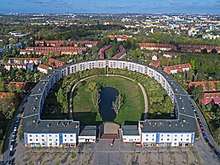
In 1920, the last of the annexations of towns surrounding Berlin gave Berlin the administrative borders it has today, then known as "Groß-Berlin" or greater Berlin. The Weimar era was probably the high point in both the importance of Berlin and its reputation in the world. The city grew - in part thanks to the aforementioned annexations - to 4 million people (a number it is inching towards today from roughly 3½ million) and was one of the most populous and influential in the world, only exceeded in population by New York City and London. In area, Groß-Berlin was the second biggest city in the world behind only Los Angeles, and the area encompassed by the city is roughly equivalent to that of Rügen. Almost all politicians, intellectuals, artists, scientists and other public figures known during the Weimar Republic lived and worked in Berlin. Potsdamer Platz (one of the first sites of a traffic light in the world) was considered one of the places in Europe with the densest traffic. The rapidly developing S-Bahn (electrified in that era) and U-Bahn mass transit systems were seen as models for the world with few equals. Tempelhof Airport (then without its iconic terminal building which was built by the Nazis) was seen as one of the best airports in Europe, and its connection to the U-Bahn showed the way for all major airports to come. Berlin was also a bustling multicultural place with people from all over the world contributing to its cultural and economic output. Rampant inequality, however, meant that not everybody participated in the boom of Berlin. The economic crisis of 1929 and the subsequent austerity measures hit the poorest disproportionally hard. Housing was scarce in the booming city, and apartment blocks intended to remedy this were built. Six groups of these buildings have been declared UNESCO World Heritage Sites under the name "Berlin Modernism Housing Estates".
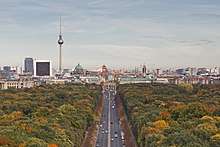
Nazi era and World War II
The Nazis wanted to redesign Berlin into a "world capital Germania", but thankfully the war put an end to those plans. The Nazi buildings that remain were built before the war and are not always associated with them, such as the Olympic Stadium (built for the 1936 games) and the terminal building for Tempelhof Airport. Berlin was hit hard and repeatedly by aerial bombardment during World War II. Unlike Hamburg or Dresden, there was no single big bombardment and no major fire, but rather a series of bombardments that leveled a lot of the city. Many historical buildings were lost and much of what is visible today is new construction after the war, or an attempt to save buildings that would have been torn down as too damaged in other circumstances. The GDR, on the other hand, intentionally tore down buildings that might have been salvageable. The Stadtschloss was seen as a remnant of feudalism and was replaced with the Palast der Republik which housed the GDR Parliament. It was torn down after 1990 due to its political associations and asbestos content. Construction of a new Stadtschloss is taking place at the same site in 2018. The opening of the rebuilt Stadtschloss is planned for September 2019. In the last months of the war, Berlin was at the heart of one of the bloodiest battles of the war as several Soviet generals raced one another to get to Berlin first because Stalin believed the Americans and British intended to conquer Berlin as well. The Nazis did not give a second thought about human lives either, and in the last weeks very old and very young men were pressed into service in an entirely futile attempt to halt the Soviet advance. A "whispered joke" making the rounds at the time among Germans said the war would be over when the Volkssturm (old men and teenagers - Hitler's last "soldiers" of any kind) would take the S-Bahn to the front. The iconic photo of a Soviet soldier raising the red flag on the Reichstag dates to that era, and graffiti made by Soviet soldiers in 1945 can still be found in the Reichstag Building.
Cold War
Berlin was divided into four sectors in accordance with the agreements of Yalta and Potsdam (the latter chosen mostly because it was the place closest to Berlin with rooms undamaged enough to be used for a conference). While the initial plan was to jointly administer Berlin and Germany, the façade broke down in Berlin first with the Soviet blockade of the Western sectors and the subsequent Berlin airlift when West Berlin was supplied by the western allies through the air making use of the airport Tempelhof, RAF Gatow and what would later become Tegel Airport.
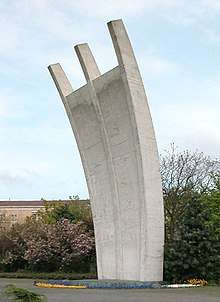
The airlift, including the dropping of small packets of candy on makeshift parachutes (an idea of US pilot Gail Halvorsen), endeared people in West Berlin to the Western allies, and eventually forced the Soviets to end the blockade. Despite the name "raisin bomber", however, the single most common good by net tonnage was coal. Due to being cut off from Soviet-occupied electricity lines, the planes also flew in an entire power plant and subsequently the fuel for it, but most coal was used to heat private homes. West Berlin later became a part of West Germany in fact if not in name: it sent non-voting delegates to the Bundestag who were nominated by the Berlin parliament rather than elected by the people; similarly all federal laws had to be approved by the Berlin legislature, which usually happened without any real vote or discussion. Crucially, Berlin was "demilitarised" and thus people in West Berlin could not legally serve in the Bundeswehr, no matter whether they were born in Berlin or elsewhere, and moving to Berlin thus became a very popular way to avoid the draft. Berlin remained the last open crossing in the increasingly militarised and airtight "inner-German" border. On August 13, 1961, the GDR leadership closed the border just days after Ulbricht said in a press conference "Niemand hat die Absicht eine Mauer zu errichten" (nobody has the intention of building a wall). The border was fortified more and more in the ensuing years with several walls. The most iconic wall made out of concrete was soon covered in graffiti on its western side which was technically still in East Berlin, but neither the East German nor the West German police were willing or able to police it.
While Berlin had taken two big hits with the war and partition, the era of Berlin partition also led to a unique development, especially in the Western half. West Berlin held a special status because it never belonged to the Federal Republic of Germany, even though it "voluntarily" applied most West German laws. A prohibition on joining the military made it a place for many students and radicals or people who wanted to avoid the draft to go. The student revolts of 1967/68 mostly took place here. It was here that young Benno Ohnesorg was shot during a protest against the Shah of Iran in 1967. This galvanised a movement against continued presence of Nazi elites, the Vietnam War and several - perceived or real - birth defects of the young German Federal Republic. This movement, retroactively called die 68er (the 68ers), had several hotspots in Germany, but it was most prominent in Berlin. Its leader, Rudi Dutschke, an East German emigrant from Brandenburg, was shot in Berlin in 1968. He survived the shooting, but died of a seizure caused by the wounds in 1979. In this era, Kreuzberg, a part of which (known then as "Kreuzberg 36" due to its postal code), was surrounded by the wall on three sides. It became a particular hotbed of leftist activism and there were frequent clashes with police all the way to reunification and to some extent to this day. During partition, artists like David Bowie came to Berlin to get inspiration. A stop at some representative place in Berlin (the Wall, the Brandenburg Gate, etc.) became a mainstay of presidential visits to the city. Ronald Reagan famously stood in front of the Brandenburg Gate (which was inaccessible due to the Wall) when he said "Mister Gorbachev open this gate; Mister Gorbachev tear down this wall."
People fed up with the situation in East Germany - and encouraged by Gorbachev's policy of glasnost and perestroika - took to the streets in increasing numbers in 1989. There was a large demonstration at Alexanderplatz in October 1989. On November 9, 1989, Günter Schabowski read aloud a new decree regarding an opening of the border during the first-ever live GDR press conference. On the subsequent question of when it would enter in force, he (erroneously) replied "sofort, unverzüglich" (i.e. immediately). This led to people flocking the border post in the belief the wall had fallen. The overwhelmed guards had no choice but to open the border, and this day became known as the "fall of the Berlin Wall". The wall was torn down in the ensuing weeks and days. Events began moving fast, and after elections resulted in a clear pro-unification majority, East Germany joined West Germany on October 3, 1990, just days ahead of what would have been the 41st anniversary of the GDR. Berlin became the capital of reunified Germany and most - though not all - governmental institutions moved there in 1998. This coincided with the end of the chancellorship of Helmut Kohl who had been in office when German unity came about and governed Germany longer than any other non-royal.

History since reunification
Despite its almost total lack of industry (what survived the war either left West Berlin or was nationalised in East Berlin and mostly went bankrupt during 1989/90), Berlin is a major draw for immigrants, particularly the young and well-educated. Berlin is slightly less well-off than the national average (unique among major national capitals), but has surprisingly affordable (though rapidly rising) rents and costs of living for a city of its size and importance. This all combines to make Berlin one of the centres of the startup phenomenon. The economic crisis in Southern Europe combined with the Erasmus program has led to a significant rise in the Spanish-speaking population in particular. Berlin also draws migrants from all parts of Germany - particularly, at least according to common cliches - Swabia. While international immigrants are usually welcomed with open arms, there is a not entirely tongue-in-cheek aversion against "Swabians", though sometimes the holders of anti-Swabian prejudice are recent arrivals as well. Since reunification, Berlin's Jewish community has been growing because of immigration from the former Soviet Union, and because young Israelis find Berlin a better place to live (and party) than Tel Aviv, Haifa or Jerusalem. An issue that has plagued Berlin in various forms since the end of the war but increasingly since reunification is that of strained municipal finances. Unlike Paris or London (or even Munich within Bavaria), Berlin does not benefit from large infusions of funds to build projects in the national capital. During partition, West Berlin was subsidised to an extent because it was surrounded by East Germany, and because it was seen as a propaganda tool to have a wealthy, successful and prosperous West Berlin right in front of the nose of the East. Meanwhile, East Berlin was seen as the pride of the East German regime and likewise first in line for any scarce resources, including housing, consumer goods and infrastructure improvements. Following reunification, there was great enthusiasm that Berlin would finally be fully reconnected to its Brandenburg suburbs and the scars of division could be healed and wounds mended. However, a planned fusion of the states of Berlin and Brandenburg was rejected by Brandenburg. Subsidies that had been granted as a matter of course were increasingly questioned, and the infrastructure of two major capitals often strains the ability of Berlin to keep up. As if this all hadn't been enough, in 2001 a major banking scandal rocked Berlin which resulted in billions of euros in losses to be absorbed by the empty state treasury. A further problem, familiar to some US cities unable to annex their suburbs, is that many who live across the state line in Brandenburg benefit from Berlin infrastructure, but pay no state tax in Berlin and are not counted among Berlin's population for the purpose of allocations of funding. To give one example of the effects of this strained financial situation: there have only been four subway extensions reaching a combined length of 6.9 km (4.3 mi) (including the 1.8-km U55) since reunification in 1990, compared with over 10 km in East Berlin during the 1980s and a veritable U-Bahn expansion spree in the West during 40 years of partition. And even then, some of the post-unification expansions were explicitly agreed to in federal law and financed almost exclusively through federal money.
While the wall is now fallen longer than it ever stood, and some scars of partition took only weeks or months to mend, there are still visible signs of where the wall once was. Some are seemingly innocuous like the lack of trams in the old west or the colour of street lights (better visible from outer space), but some are kept in place on purpose to remind locals and visitors alike of that phase of history. Sadly there was a certain post-reunification iconoclasm of all things GDR. While many things (particularly the monuments to the Soviet soldiers) were kept, the most notable victim of a drive to tear down all relics of Communist government was the Palast der Republik. It was torn down in part because of asbestos contamination, but also to restore the former Prussian Stadtschloss, which had been torn down by GDR iconoclasts to make way for their reorganisation of the city.
Climate
| Berlin | ||||||||||||||||||||||||||||||||||||||||||||||||||||||||||||
|---|---|---|---|---|---|---|---|---|---|---|---|---|---|---|---|---|---|---|---|---|---|---|---|---|---|---|---|---|---|---|---|---|---|---|---|---|---|---|---|---|---|---|---|---|---|---|---|---|---|---|---|---|---|---|---|---|---|---|---|---|
| Climate chart (explanation) | ||||||||||||||||||||||||||||||||||||||||||||||||||||||||||||
| ||||||||||||||||||||||||||||||||||||||||||||||||||||||||||||
| ||||||||||||||||||||||||||||||||||||||||||||||||||||||||||||
Berlin has a temperate oceanic climate, meaning warm summers and cold winters. Nighttime temperatures typically fall below freezing in the winter, and snowfall is a regular occurrence, though the snow rarely accumulates for more than a few days. Summers are typically pleasant, with daytime temperatures typically in the low 20s, and nighttime temperatures staying above 10 °C. Berlin is a rather windy city compared to much of Southern Germany, though by no means as windy as coastal cities like Hamburg or Lübeck. A wind-stopping jacket comes highly recommended, especially during the shoulder seasons.
People
As a city that grew from an assortment of minor towns in a backwater of Europe to the third biggest city in the world in barely more than two centuries, Berlin has always been a place where being "from elsewhere" was the rule rather than the exception. During GDR times, East Berlin attracted many people from the countryside and other cities as new housing was built at a faster rate there to alleviate the housing shortage. Furthermore, Berliners often enjoyed slightly fuller shelves and shorter lines in supermarkets than other East Germans. In the West, some people did leave Berlin due to its "insular" geography and others came in due to the exemption from the draft. Today Berlin draws people from Germany and from all over Europe. You will find a diaspora of very close to every ethnicity, religion and national origin in Berlin. This means that Berlin is able to constantly reinvent itself, but a Berliner born-and-raised is something of a rare sight outside some outlying neighbourhoods.
Nowadays the conflicts between Easterners and Westerners are often replaced by jokes about Swabians, who have a reputation for thriftiness, uptightness and an audible dialect. Many Swabians have flocked to neighbourhoods like Prenzlauer Berg, and the welcome hasn't always been warm. Make no mistake, however, often those complaining the loudest about "Swabians" or gentrification are relatively recent arrivals themselves.
Berliners are notorious for a certain type of "humour" that can come across as just plain rudeness to those not accustomed to it. The stereotypical Berliner has a reputation for impolite directness even among Germans who in general see little use in pleasantries and small talk.
Berlin is also a remarkably irreligious city with only about a quarter of the population belonging to either the Protestant or Catholic Church as tracked for tax reasons. Media – especially those of a conservative bent or based in mostly Catholic southern Germany – have consequentially taken to calling Berlin "capital of Atheists".
Talk
Signage and automatic announcements are often available in English (and possibly other languages besides German), and all signage related to the partition era is available in all three languages of the former occupiers (French, Russian and English). There are, however, surprisingly many people who speak little or no English. In particular, elderly people or people who grew up in the East (where Russian was taught in schools) often have little or no English, though that does not necessarily keep them from attempting to speak English with you if they notice an accent or halting German.
People who work in public transit and the tourism sector are now expected to speak at least some English, but they may not necessarily have much patience explaining the same thing over and over to tourists every single day and the aforementioned Berlin rudeness/"humor" might come through even when dealing with tourists.
There are also 400,000 people of Turkish origin living in Berlin, mainly in the western districts. Many of them arrived in the early 1960s from remote villages in Anatolia as guest workers but stayed on and had German-born children of varying citizenship.
Since the early to mid-2000s Berlin has attracted foreign students from all over Europe. Due to the economic crisis in Southern Europe there are a lot of Spanish, Greek and Italian students in Berlin. As many students in Berlin are either Erasmus students or have been abroad elsewhere, you can reasonably expect students to speak at least passable English and often another European language.
Berlin dialect is still spoken by many people, particularly in outlying districts and neighbouring Brandenburg. Dialect is usually more pronounced in the East and some words are almost entirely unknown even in West Berlin.
Some words used in the Berlin dialect:
- Schrippe: (bread)roll
- Stulle: sandwich
- Broiler: grilled chicken (people from western Germany and former West Berlin probably won't understand this; they say Grillhähnchen instead)
Economy
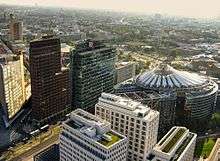
Before the Second World War, Berlin was a centre for major German industrial companies and the administrative headquarters of many companies in all fields. However, soon after the war ended, many of these companies moved south or west, went bankrupt, or were nationalised in the GDR. Berlin consequently has become a centre of research, rather than of production. While some company headquarters have moved to Berlin since reunification, the dominance of the capital is much less pronounced in the German economy than in that of most other European countries. Despite the economic boost resulting from the country's capital moving back to the city, Berlin's unemployment rate soared over 10%. Berlin is also known in Germany for being a centre of creative branches such as design and arts of all kinds -- you will see a lot of people working (or not depending on your definition of the term) with Apple products in some coffee shops.
Orientation
As Berlin grew from several different towns and villages, there is not one centre per se but rather several centres which can make orientation a bit difficult. Berlin's U- and S-Bahn bear the scars of three decades of partition and of post-reunification lack of funds. They originated as a hodgepodge of lines constructed by private companies and (then) independent cities. Some lines use a loading gauge ("Kleinprofil") that is different from other lines, making through running a technological challenge. In that, the Berlin U-Bahn is not too different from the New York City Metro. Routes are indicated by number and the name of their endpoint, so memorise them lest you want to go many kilometres into the wrong direction. A good public transit map comes in handy, and several institutions hand out city maps with urban rail stops indicated on them. The U-Bahn, S-Bahn and (in the former East) Straßenbahn are still a good way to get around. The buses are also clean, reliable and relatively fast.
The apocryphal adage about Washington DC's street layout being designed to confuse invading armies could apply to Berlin as well, if it were designed by anybody to do anything at all. Berlin's streets are confusing and follow no logic to speak of, owing to the development of the city and to decades of partition. Cardinal directions are of little use: close to nothing is aligned straightforwardly east-west or north-south not even the former border. Street signs therefore usually bear the names of boroughs and sometimes local landmarks, rather than "North", "South", "East" or "West". At any rate, driving a car in Berlin should be avoided if you can, but cycling can be a worthwhile way to experience the city if you are aware of the distances.
There may be different streets of the same name scattered across the city. For example, there are at least three streets named "Potsdamer Straße": one in Lichtenrade, one in Zehlendorf and another one in Giesendorf. This is not an uncommon thing in Berlin in part due to it having been a bunch of separate cities and villages. (Some of the more common names have since been changed, but by far not all of them.) It is a good idea to always keep in mind which district you are travelling to. German postal codes are pretty fine-grained and usually the same street-name should not appear twice in the same code, so try and use the full address with postal code and/or district. Taxi drivers somehow have to (and usually do) know most of those strange and repeating street names. As Istanbul-born comedian Serdar Somuncu quipped with regard to the many Turkish-descendant taxi drivers, "A German wouldn't go to Istanbul to become a taxi driver, yet countless Turkish taxi drivers get people to one of the three dozen Goethe Straßen in Berlin without fail every day".
House numbers do not necessarily run in the same direction (up or down) everywhere. On a lot of streets, the numbers ascend on one side and descend on the other. So to avoid getting you lost, you should check the numbering scheme first: you can find the name of the street at nearly every street corner. The same sign will usually state the range of house numbers in that segment.
Berlin in popular culture
As a city of its size and importance, there are more works of fiction than could conceivably be listed by a travel guide, so this list does not attempt to be exhaustive. While Berlin's cultural output never ceased (and indeed some fields got a lot of inspiration by the divided city), it probably reached its peak in the 1920s. It is working its way towards a new peak with the ascendant and reunified Berlin once more seeking and finding its place on the world stage. As Berlin had the cultural infrastructure of two major capitals during partition, there are theatres, operas and universities galore. These are a drag on the empty municipal coffers and lead to complaints by people from other parts of Germany about subsidies, but they help keep one of the most vibrant cultural scenes in Europe alive.
- Berlin Alexanderplatz, written by Alfred Döblin in 1929, captures the Berlin of its time and was turned into movie twice. The most famous version is the 15½-hour magnum opus of Rainer Werner Fassbinder that was broken up into 14 episodes to be shown on television.
- Run Lola Run (German: Lola rennt), a 1998 movie about a small time criminal and his girlfriend set and filmed in Berlin. The plot is about Lola trying to get 100 000 Deutsche Mark for her boyfriend within 20 minutes. It is notable for its narrative style: it tells three different versions of the same story depending on Lola's decisions. It was one of the biggest post-reunification successes of German cinema.
- Good Bye, Lenin! (2003) set in East Berlin during the 1989/90 transition. The premise of this movie is the protagonist trying to ensure his mother, who fell into a coma shortly before the fall of the wall and awakened shortly afterwards, doesn't realise the GDR is no more. Making extensive use of typical East-Berlin scenery, among it Plattenbau housing and Karl Marx Straße, the movie is credited with kickstarting the "Ostalgie" (nostalgia for the GDR) trend of the 2000s and early 2010s.
- Berlin Calling (2008) movie by German electronic music DJ Paul Kalkbrenner about a substance abusing DJ (Kalkbrenner) and his life in Berlin set to music by Kalkbrenner and others.
- The Kangaroo Chronicles (2009) by Marc Uwe Kling; Kling, who lives and works in Berlin, narrates his fictitious life with a communist kangaroo roommate; the two engage in several hijinks (often of a political bent) and often hang out in a typical Berlin Eckkneipe (including stereotypical Berliner owner) philosophizing about the injustices of capitalism and how modern society induces laziness. His minor characters often speak in stereotypical Berlin dialect and his observational comedy is spot-on. Kling frequently organises and hosts poetry slams in Berlin and has in the past read texts from his Kangaroo related works there as well.
Get in
As the city was divided into two during the Cold War, many major parts of Berlin's infrastructure — such as airports — were built on both sides. The challenge today is to merge these two systems into one that serves all the people in the Metropolitan Berlin area. In terms of railway stations, this process is mostly finished, but the airport and bus station situation is still far from satisfactory.
By plane
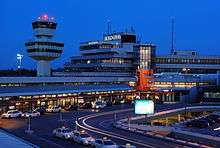
Berlin inherited airports from both sides of the Berlin Wall. West Berlin, for which air transportation was crucial, had three at the moment of reunification: RAF Gatow, which was only used by the British and closed in 1994, Tegel Airport (TXL IATA), which remains the major airport for Berlin as of 2019, and Tempelhof Airport, which was closed in 2008 and turned into a public park and fairgrounds. East Germany's main airport was Schönefeld Airport (SXF IATA) right outside the southeastern border of the city proper, which also remains operational as of 2019.
A new airport, Berlin-Brandenburg Airport (BER IATA), is being built on the extended grounds of Schönefeld, however it is not yet operational. TXL and SXF have not been updated for the past years, since they were scheduled to be replaced by BER years ago, while they are in dire need of update and expansion given current traffic volumes and advances in air travel. TXL in particular handles far more traffic than it was designed for.
Carriers frequently switched between TXL and SXF in recent years and, although one carrier tends to serve one airport only, there is a very mixed bunch of connections from each airport. The bankruptcy of Air Berlin has led to several airlines which previously only served Schönefeld offering flights from Tegel making the confusion ever so slightly bigger. Make sure you know which airport you are arriving at, especially if you have a connection to make, and if you've been sold a ticket to BER before it becomes operational.
Tegel International Airport
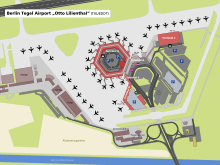
🌍 Tegel International Airport (TXL IATA) (north-west of the city). Tegel was the airport for the French sector and later the dominant airport of West Berlin during the Cold War. Today, Tegel is served by legacy airlines such as Air France, British Airways, KLM, Lufthansa and United. The original airport was intended as a double hexagon, though only one hexagon was ever built (terminal A) plus two non-hexagonal terminals (terminals C and D). All legacy carrier flights depart from the main terminal building A (Terminal B contains only the bus gates of Terminal A for non-Schengen flights), and is also where all airlines lounges are. Tegel has more than ten times as many domestic passengers as Schönefeld.
British Airways, Iberia, Finnair and Qatar Airways operate direct flights to Tegel from their hubs. Lufthansa itself only operates flights from Tegel to its hubs: Frankfurt airport and Munich airport. Lufthansa's low-cost subsidiary Eurowings operates flights to some European destinations. United Airlines continues to operate a direct flight to Newark. Most European, North African and Middle Eastern Star Alliance airlines, as well as SkyTeam members, have direct flights from their main hubs to TXL.
Tegel has an unusually efficient structure because it was built as an origin-and-destination airport only, which resulted in very short walking distances between the taxi ranks and bus stops to the actual gates. The hexagonal structure of the main terminal allows individual gates to have their own check-in/luggage drop-off desks, security control and separate waiting areas. This makes flying out of the main terminal building a very swift and comfortable experience. Connecting via Tegel may not be as comfortable, though, because you will probably need to go through security anyway, and there is quite a walk (outside!) between terminals, particularly Terminal C. Except for Terminal A, no gates have jetways and you will need to either be ferried by bus or actually walk from the plane to the terminal. The waiting space and shopping within Tegel is also limited and not really top-notch. The luggage handling capacities of Tegel have long been exhausted, which sometimes leads to well-publicised massive "luggage lost" incidents.
Tegel Airport offers 60 minutes at a time (renewable) of free Wi-Fi, although the access is limited to web access and doesn't support non-Web email clients, VPN, or SSH.
Tegel to central Berlin
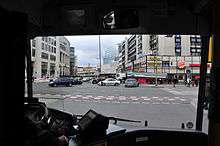
The only means of public transportation operating directly from the airport are buses. There are four bus lines, all operated by BVG and thus included in the same ticket scheme as the rest of Berlin. Tegel is in ticketing zone B, so it is covered by "zone AB", "zone BC" and "zone ABC" tickets. The four lines are:
- TXL express bus to Alexanderplatz, stopping at the Hauptbahnhof, the Brandenburg Gate and the corner Unter den Linden and Friedrichstraße. The full travel time to Alexanderplatz is 39 minutes, while travel to Hauptbahnhof takes 22 minutes according to official schedules.
- X9 express bus to Zoologischer Garten railway station, with only 6 stops along the way and a 20 minutes travel from terminus to terminus it is the fastest option to get into the city
- 109 takes a longer route to Zoologischer Garten, stopping in many locations in West Berlin including Schloss Charlottenburg and Adenauerplatz. From Adenauerplatz onwards it traverses the most popular part of Kurfürstendamm. The full route to the terminus at Zoo takes 28 minutes.
- 128 goes north-east from the airport to the U-Bahn station Osloer Straße in the north of the city, stopping at many local stops and taking 25 minutes to complete its route. It is of little use to most travellers, unless their specific destination lies close to that particular route.
All buses, both express and regular, require the same regular tickets and operate every 10 minutes (every 20 minutes at night). All buses stop on the main (upper) deck of the Tegel ringroad - TXL and 128 stop in front of the main entrance of terminal A, while X9 and 109 around the corner, in front of the so-called Terminal B. There are automatic ticket machines at all bus stops selling all kinds of tickets and accepting cash (Euros) or credit cards. Berlin WelcomeCards can be bought at the tourist information kiosks in the airport terminal and sometimes from the BVG employees on duty at the bus stops (during peak travel times).
Tegel International Airport does not have a railway station. Do not take any train to the "Tegel railway (S-Bahn) station", which is not connected to the airport, but rather to the suburban village called Tegel. It is not possible to walk or to otherwise get easily to the airport from that station. Any indication to a Tegel railway station refers to the remote S-Bahn station, even if railway staff at stations in other cities might tell you otherwise. The nearest train stations are:
- Jakob-Kaiser Platz on the U-Bahn line U7 (5 minutes from the airport with bus X9/109)
- Kurt-Schumacher Platz on the U6 (10 minutes from the airport with bus 128)
- Beusselstraße on the S-Bahn ring line S41/S42 (8 minutes from the airport with the TXL bus)
If you want to connect to mainline (long-distance) railway, you need to travel to Hauptbahnhof on either of the buses. Südkreuz and Gesundbrunnen also see long distance trains from Berlin and lie along the ring S-Bahn, whereas Spandau is in the boondocks and awkward to reach from Tegel Airport.
Schönefeld Airport

🌍 Schönefeld Airport (SXF IATA) (southeast of Berlin). Once East Berlin's airport, now a base for most low-cost airlines (including easyJet, Ryanair and Norwegian) and charter flights. Many airlines from Russia, former Soviet states and eastern Europe use SXF as their Berlin airport as they did in the days of East Germany. (Some have switched to TXL.) There are also many charter and scheduled flights to Bulgaria and Israel.
Schönefeld to central Berlin
The airport is served by the S-Bahn and regional trains. The station is a short walk, under a covered, well-lit walkway opposite terminal A/B. There are two types of trains operating from that station - the slower but more frequent S-Bahn and the faster regional trains (Regionalbahn/Regional Express). The station is in Zone C of the BVG network, so you need a ticket covering all three zones (ABC), or a BC ticket if you do not intend to travel directly into the city centre. The same tickets are valid in both S-Bahn and regional trains if you travel from Schönefeld Airport into Berlin. A single ABC ticket that will get you anywhere in Berlin costs €3.40 (regular fare ‘ABC’ single journey ticket - Einzelfahrschein). Stamp the ticket to validate it before boarding. Check out timetables, platform numbers and fares on the BVG website.
- Regional trains (RE7 or RB14) are calling at the major train stations in the city centre. They depart once an hour each between 05:00 and 23:30, spaced about 30 minutes apart, which means you have two chances per hour to catch either of them. The journey takes approximately 25 minutes to/from Alexanderplatz; 30 minutes to/from Berlin Hauptbahnhof and 35 min to/from Zoologischer Garten. Other stations served within Berlin are Ostkreuz, Ostbahnhof, Friedrichstraße, Charlottenburg, Spandau (RB14 only) and Wannsee (R7 only). Attention: While RE14 finishes its run at the airport, the RE7 goes further south to Wünsdorf-Waldstadt, so make sure you board the train going in the right direction (RE7 going from the airport into Berlin terminate at Dessau or Bad Belzig).
- S-Bahn trains (S9 or S45) run every 20 minutes each (so there is a departure around every 10 minutes) until around 01:30. While the S9 crosses the city centre and stop at many more stations than the regional trains, the S45 is using the southern part of the S-Bahn-circle to Berlin-Südkreuz and beyond, so a journey to the centre using this S-Bahn might require a longer ride and a change of trains.
- The S9 runs through East Berlin and then crosses the city-center on east-west direction, calling at Ostkreuz, Alexanderplatz, Friedrichstrasse, Hauptbahnhof, Zoologischer Garten, Charlottenburg, Olympiastadion to the western district of Spandau.
- the S45 connects to the circle-line (Ringbahn) and also runs along its southeastern stretch through in.al. stations Neukölln, Tempelhof and Schöneberg, serving the namesake districts, terminating at Westend in Charlottenburg. You can change to U-Bahn lines U4, U6, U7, U8 and U9 at various stations along the S45 route. You can also change to S-Bahn trains travelling on the north-south tunnel through the city centre at Südkreuz.
The airport is also served by buses:
- You can take the express city bus line X7 from Schönefeld Airport to U-Bahn line U7 terminus Rudow. The bus is direct (no intermediate stations) and takes just 7 minutes to complete the route, running every 10 minutes at daytime and 20 in nighttime. The U7 is the longest in the Berlin network serving most southern and western districts of Berlin well. The U7 does not go to the core city centre, but you can change from it to other lines that do. If for some crazy reason, you need to go all the way to Spandau, the U7 will take you there as well as the S9.
- Other city buses from Schönefeld serve locations around the airport in Berlin and beyond, sometimes stopping at a railway station on their way, but they never afford any time gains over the direct train connections or X7.
Berlin-Brandenburg Airport
The opening of Berlin-Brandenburg Airport (BER IATA), which is being built on the extended grounds of Schönefeld, was scheduled for 2011 but has been postponed many times due to construction and safety issues. As of March 2019, it is not yet operational. Every few months a new date is announced and, therefore, much of the tourist information has been published in recent years with the "impending" opening of BER and closure of TXL and SXF in mind. Bear in mind that until the BER airport is opened, those remain incorrect and there is no passenger traffic to and from BER and much of the infrastructure there not functional. As of January 2018, the airport is scheduled to open in Autumn 2020, with some reports predicting a 2021 or 2022 opening instead. The history of delays has made many Berliners (scratch that, most Germans) skeptical.
When construction of BER was approved it was decided to close Tegel half a year after the new BER airport starts operations. A non binding referendum on whether to reverse the decision to close TXL after BER opens was held in September 2017 together with the federal elections resulting in the Berlin government being "urged" to "do everything in its power" to keep Tegel open - no small thing to ask, given that the state of Brandenburg and the federal government would also have to sign of on Tegel being kept open. The governing mayor of Berlin, who is personally opposed to keeping Tegel open announced he'd "look into it" upon the results being announced. Neither the state of Brandenburg nor the federal government have signaled any willingness to keep TXL open, much less spend any significant sum of money to do so.
According to the original plan the Schönefeld airport will close if and when BER airport starts full operations, however as of 2017 there are now debates about using some of SXF's infrastructure for additional capacity at BER once it opens at least for a transitional period.
A train station serving the new BER is already operational and served by empty trains every once in a while in part to ensure driver familiarity and to guarantee air movement to delay or prevent the onset of mold in the station building. There is a plan to reopen the old "Dresdner Bahn" which had been partially shut down during partition for faster connections to the airport and while questions about financing and protests by local residents have delayed construction in the past, it is now conceivable that this new rail line will be ready before the airport.
By train
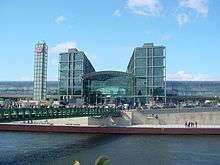
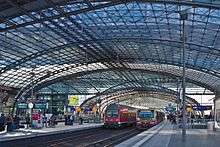
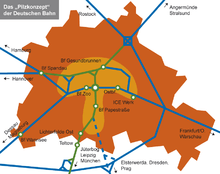
- Wikivoyage has a guide to Rail travel in Germany
The central station 🌍 Hauptbahnhof (Central Station) together with 🌍 Südkreuz (southern cross, formerly Papestraße) and 🌍 Ostbahnhof (eastern station) — plus minor 🌍 Gesundbrunnen in the north and 🌍 Spandau in the west — forms the backbone of all connections. All are connected to S- or U-Bahn. All trains stop at Hauptbahnhof and a second major hub (depending on your itinerary). Regional trains stop at several stations within Berlin, almost all of them also at Hauptbahnhof and all stop at least at one major long distance hub. The Hauptbahnhof opened in 2006 and is situated between the S-Bahn stations Friedrichstraße and Bellevue. It is itself an impressive feat of architecture with many shops, most of them open on Sundays. Given its size, the distances between train plaforms are surprisingly short. However, try to avoid tight connections, as the multilevel layout can be confusing at first and Berlin Hauptbahnhof is a good place to kill half an hour at any rate. The new 'Hauptbahnhof' may appear as 'Lehrter Bahnhof' on older maps.
On the U-Bahn Hauptbahnhof is served only by the short U55, but construction to link it to U5 is ongoing. Three S-Bahn lines (S3, S5, S7) serve the station as do three tram lines (M5, M8, M10). In addition to the extension of U55 towards U5 (and thus to East Berlin), the tram lines now mostly serving the East are planned to be extended westward and a new S-Bahn line, tentatively called "S21" is under construction serving as another North-South spine through Hauptbahnhof.
During partition Berlin had two main train stations: Zoologischer Garten (practically universally referred to in speech as Bahnhof Zoo or just Zoo) in the West, and Ostbahnhof in the East. The latter was named "Hauptbahnhof" from 1987 to 1998. Since the opening of the Hauptbahnhof, most ICE and international lines no longer stop at Zoologischer Garten, although regional DB services and S+U-Bahn services still stop there.
Berlin is served by all the train types Deutsche Bahn (DB) has on offer, including high speed ICE, somewhat slower IC and Eurocitys (EC) operated by DB and/or other European railroad companies. Connections to the rest of Germany are excellent and most of Europe is reachable with one or two changes. While train routes to Berlin suffered during partition, they were a high federal priority following reunification and today Berlin has fast train connections to the west and south. Trains due north and east are still a bit slower. For example, the line to Dresden is slower today than it was in the 1930s when streamlined steam trains plied the route.
Domestic trains to Berlin include ICE service from Hamburg, Munich via Leipzig/Halle, Erfurt and Nuremberg with the fastest trains arriving in Munich less than four hours after departure in Berlin. IC/EC services from Dresden and several "regional" trains among which the IRE to Hamburg (longer travel time than ICE, more intermediate stops) might be of interest due to its cheap fixed price (€19.90 one way, €29.90 round trip). Berlin is also a stop for several "ICE Sprinter" services - ICE trains with fewer or no intermediate stops intended to lure business travelers from planes onto trains with faster travel times.
Berlin is also served by a private competitor of DB : Flixtrain, but keep in mind that Flixtrain doesn't accept any DB tickets and vice versa. They run one train per day and direction to and from Stuttgart via Wolfsburg and other stops. Tickets are sold through Flixbus which is mostly a bus operator. Flixtrain trains have four stops in Berlin; Lichtenberg, Ostbahnhof, Hauptbahnhof and Bahnhof Zoo. Flixtrain is thus very close to the only long distance train service at the former hub of West-Berlin Bahnhof Zoo.
The Austrian railway company ÖBB (under the name Nightjet) run sleeper trains between Berlin and Vienna (11 hours) and Berlin and Zürich (12 hours). Since 2016 Deutsche Bahn no longer run sleepers.
There are also long-haul trains from Moscow via Minsk and Brest, run by RZD at least once a week, with greatly increased departures during spring and summer season. From the other direction, this train originates in Paris a night before, making it an handy overnight connection between the two cities - and the only sleeper train between Germany and France. Apart from a summer-only service from Kaliningrad, there are as of 2017, no other overnight trains from Eastern European and Russian cities.
By bus
🌍 Zentraler Omnibusbahnhof (ZOB) (Central Bus Terminal) (in Charlottenburg, Masurenallee.). Long distance buses generally arrive here. There are numerous buses to all directions and the U-Bahn stops (Theodor-Heuss-Platz or Kaiserdamm; both U2) or the S-Bahn stop (Messe Nord/ICC S41/42 and S46) is a 5-minute-walk away. Follow signposting. Some bus lines have other stops around Berlin, often including Südkreuz and/or one of the airports. The bus station is not really close to anything. Retail services are limited and the prices as high as one might expect at a gas station. From 2016 to 2022 the station is undergoing renovation and expansion to cope with rising and changing demand - the station will remain operational throughout the expansion but some services may become temporarily unavailable. As part of the purpose of the works is to reduce average dwell times from half an hour to 15 minutes it will also benefit those just driving through or connecting. The bus station website lists all departures and arrivals including the company running the service so it is a good place to look for up-to-date travel options.
By car
Berlin's "capital beltway", the A10 Berliner Ring, extends up to 30 km (19 mi) outside the city limits and actually only touches Berlin itself in the Northeast. It was built in the GDR era as the longest circular motorway in the world to direct traffic around West-Berlin but has since been surpassed in length by Beijing's sixth ring road and also Beijing's seventh ring road when it opens. At 196 km (122 mi) it is 8 km (5.0 mi) longer than M25 around London, Europe's second longest circular motorway. These motorways (enumerated in a clockwise direction) connect with the ring:
- A11 from Stettin at Dreieck Schwanebeck
- A12 from Frankfurt (Oder)/Warsaw at Dreieck Spreeau
- A13 from Dresden/Prague at Kreuz Schönefeld
- A9 from Leipzig/Munich at Dreieck Potsdam
- A2 from Hanover/Dortmund at Dreieck Werder
- A24 from Hamburg at Dreieck Havelland.
From the ring, these are the motorways heading towards the city:
- A111 from the northwest at Kreuz Oranienburg
- A114 from the north at Dreieck Pankow
- A113 from the southeast at Schönefelder Kreuz
- A115 from the southwest at Dreieck Nuthetal.
There are also dual carriageways:
- B96 from the north and the south
- B2 from the northeast
- B5 from the east and west
- B101 from the south.
Inside Berlin there is a heavily congested inner ring motorway (A100), which encircles the north, west and south with the northeastern section missing. Berlin driving is not for the faint-hearted, but manageable as there are wide streets and reasonably good parking conditions - at least in most parts of the city.
Berlin has a low emission zone (Umweltzone), which contains all areas within the S-Bahn ring. All vehicles moving inside this zone (including foreign vehicles) are required to bear a green emissions sticker (Feinstaubplakette). There are exceptions, e.g., for historic cars, but not for foreign number plates. The sticker can be ordered on-line.
By ship
Being some 200 km (120 mi) inland, Berlin does not have a seaport. The nearest seaport is Rostock-Warnemünde, which is between two and a half and three hours away by train, though still sold by many cruise ship operators as "Berlin", so don't be surprised. There are similar distances to the seaports of Hamburg and Szczecin.
Some river cruises start or end at Berlin, using Havel, Spree and some canals for cruises to Prague or the Baltic Sea. While river cruises in this area are nowhere near as popular as those along Rhine or Danube, there is some charming nature rather close to Berlin. Most cruises include a tour of Berlin as the river Spree runs close to many sights.
By bicycle
The 700km Berlin-Copenhagen Cycle Route and the 340km Berlin-Usedom Cycle Route both end in Berlin.
Get around
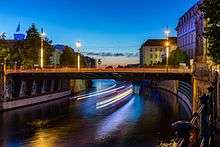
By public transport
As Berlin is a major metropolis with pretty decent public transit, you should take buses, trains and trams whenever possible as those cover most of the city and are often the fastest way to get to places. The Berliner Verkehrsbetriebe (BVG) list all their fares on their website. Consult their Berlin route planner (in English) to get excellent maps and schedules for the U-Bahn, buses, S-Bahn and trams, or to print your personal journey planner. The route planner can also calculate the fastest door-to-door route for your destination for any given day and hour. However, the route planner assumes a rather slow walking speed. It might suggest taking a bus or tram for a single stop where healthy adults would be faster walking. The planner will let you pick between three walking speeds, but even the fastest walking speed is not terribly fast if you have no luggage.
- BVG's customer service, ☎ +49 30 19449. If you don't know how to get somewhere, or how to get home at night, BVG's customer service number. Most U-Bahn and some S-Bahn stations have call points from which you can contact customer service directly. Some BVG buses and tram lines run 24 hours a day, seven days a week.
Tickets
The public transport system in Berlin (U-, S-Bahn, bus, tram, regional rail) uses a common ticket system based on zones (zone A, B and C). You are unlikely going beyond zone A and B, except on trips to Potsdam or to Schönefeld Airport (SXF). The border between zones A and B is the S-Bahn Ring (see below). Zone C includes trips to and within Potsdam.
The following tickets can be used for single journeys:
- Single Ticket. The standard single journey ticket. It is valid for any travel within two hours of validation, in a single direction, within the appropriate fare zones. There is no limit to transfers. Return journeys are not allowed. Price: Berlin AB €2.80 (reduced €1.70); Berlin ABC €3.40 (reduced €2.50).
- 4-trip ticket (4 Fahrten Karte). This gives you 4 single trip tickets at a cheaper cost. Price: Berlin AB €9.00 (reduced €5.60).
- Short trip (Kurzstrecke). For a single journey you can buy a cheap Kurzstrecke for €1.70, but this is only valid for 3 stops on the U-Bahn or S-Bahn (transfers permitted) or 6 stops on buses or trams (no transfers). The stations included in a short tip ticket are indicated on schedules posted at bus and tram stops.
Several options are available for unlimited travel:
- Day Ticket (Tageskarte). A day ticket for one person. Worth it if you are travelling more than two trips a day. Valid until 03:00 the next morning, not 24 hours! Price: Berlin AB €7 (reduced €4.70); Berlin ABC €7.70 (reduced €5.30).
- Small Group Day Ticket AB (Kleingruppen-Tageskarte). A day ticket valid for up to five people. For groups of three or more, this ticket is cheaper than individual day tickets. Price: Berlin AB €19.90, Berlin ABC €20.80.
- 7-Day-Ticket AB (7-Tagekarte). A ticket valid for seven days. Price: Berlin AB €30, Berlin ABC €37.50.
- Berlin CityTourCard. Ticket valid for all public transport services in Berlin, Potsdam and the surrounding area (depending on the covered zones) and a discount card for many tourist attractions; available in several different versions: 48 hours AB €17.40; 72 hours AB €24.50; 5 days AB €31.90. Add a few euros if you want to go to Potsdam (fare zone ABC). A folded leaflet with inner city map and an overview of the S-Bahn and U-Bahn railway networks of Berlin is included. Can be bought at ticket machines and various sales points (Berlin airports, larger train stations, hotels or online).
- Berlin WelcomeCard. Unlimited travel with all methods of public transport for the validity of the ticket; save up to 50% on more than 200 tourist and cultural highlights; handy guide in pocket book format with insider tips and tour suggestions; city plan for Berlin and Potsdam and a network plan for public transport. Can be bought at various sales points (Berlin airports, larger train stations, hotels or online).
Tickets valid for only B and C are available as well, which you might need for a single trip to Schönefeld Airport from somewhat out of the way lodgings. There is only one way to get a ticket only valid in A: Deutsche Bahn offers "City Tickets" as an add-on for their long distance train tickets and in Berlin those are only valid for a single trip inside the A zone.
Reduced fares apply for children 6 to 14. Children under 6 ride free.
Purchasing tickets
All tickets are available at vending machines at U- and S-Bahn platforms. English and other European languages are available. Payment is mostly by local bank cards, coins and banknotes. If you need assistance most larger stations have staffed ticket counters where you can ask questions and buy tickets. Buses will accept cash, and make change for tickets. Hotels may sell tickets as well. It is also possible to purchase tickets via the BVG mobile app.
In some places people will try to sell used tickets to you. Be aware that you can go only one direction with a single-journey ticket (check the validation stamp and be careful as this could also be a pickpocket trick). Don't pay more than half the price.
Validating tickets
You need to validate your ticket using the machines on the U- and S-bahn platforms or in the bus. The machines are yellow/white in the U-Bahn and the bus, and red on S-Bahn platforms. Validation simply means the machine prints a time stamp onto the ticket. Once validated, a ticket which is still valid will not have to be re-validated before each single trip. Whilst it might be tempting to try to avoid buying a ticket, plain-clothed inspectors do patrol the trains. There is a €60 fine if you are caught with an unvalidated ticket or without a ticket. Ticket inspections are arguably more common than in other cities and the inspectors more strict than in other cities. Don't even try to outrun one. They'll catch you and be all the more pissed at you. In some cases fare inspectors have not shirked from using physical force to restrain would be fare-evaders. Even first time fare-dodging is a criminal offence, but it rarely goes to court unless for repeat offenders.
By train 

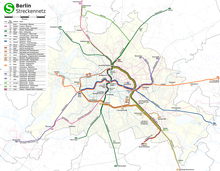
If you need to get around the city quickly, take the S-Bahn.
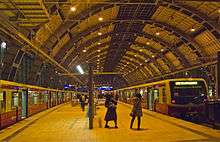
The Ringbahn that goes all around Berlin in a circle (or as local politicians would have it "a dog's head") lets you get to other parts of the city really fast. If you're looking for the way, use BVG.de, that site includes Buses, U-Bahn, S-Bahn, Tram and even ferries. You can simply enter departure address and arrival address to see the optimum connection, it's an excellent service.
The S-Bahn originates from a circular railway ("Ringbahn") and an East-West trunk ("Stadtbahn") built in 19th century to provide better connectivity between the terminus stations (similar to the way train stations are laid out in Paris or London today) which were later quadruple tracked with two tracks electrified for S-Bahn service (and later two tracks electrified with the mainline system) and in the 1930s a North-South Tunnel was added exclusively for the S-Bahn. The four stops where those intersect are named (x-)kreuz (x being the cardinal direction) with the exception of the Northern one which is officially Bahnhof Gesundbrunnen but sometimes referred to as "Nordkreuz". So there is Ostkreuz, Westkreuz, Südkreuz and Gesundbrunnen. The S-Bahn was neglected in the West during most of Berlin partition (see infobox for the reasons why) and some routes that were abandoned in this era are still not rebuilt and maybe never will. The S-Bahn is being expanded, however, and the network is now seamless: the former border is hardly ever notable to the casual observer. In the centre, most S-Bahn lines S5 , S7 , S75 run on an east-west route between Ostkreuz and Westkreuz via the stops Warschauer Straße, Ostbahnhof, Jannowitzbrücke, Alexanderplatz, Hackescher Markt, Friedrichstraße, Hauptbahnhof, Bellevue, Tiergarten, Zoologischer Garten, Savignyplatz and Charlottenburg. Other lines run along a circle track around the city, most notably the S8 and the S41 , S42 , S45 , S46 lines, and there's also a north-south connection S1 , S2 , S25 from Gesundbrunnen through Friedrichstraße and Potsdamer Platz to Südkreuz or Schöneberg.
|
S-Bahn woes All of Berlin's public transit systems have been affected by the city's turbulent history in one way or another but probably none more than the S-Bahn. Based upon tracks mostly built during the Kaiserreich, the S-Bahn started to become distinct from other trains during the Weimar Republic and was expanded by the Nazis ahead of the 1936 Olympics - based on plans already existing before their power grab. It got damaged in the war (not least by some Nazis blowing up the North-South tunnel flooding the S-Bahn and much of the U-Bahn in the process) but much less than through later politics. Upon partition, "Deutsche Reichsbahn" was granted the rights to operate the S-Bahn in all sectors of the city. Deutsche Reichsbahn would thus remain the name of the GDR state railway until reunification. In 1949 the workers on the S-Bahn in the West went on strike and while the issue was resolved, it showed problems to come. The wall went up in 1961 and on that day several connections were severed and some lines have not returned to service since. The construction of the wall also showed people in West Berlin just what the East was capable of and just how powerless they were. The S-Bahn however was an easy way to hit the East: it had been a fairly steady source of hard currency until that point but now a broad consensus from right wing press to social democratic politicians were in agreement to boycott the S-Bahn. Slogans like "we won't pay for Ulbricht's barbed wire" discouraged people from riding and bus or subway lines were intentionally run parallel to the S-Bahn. The GDR did not raise fares for propaganda reasons and to keep the last few riders riding, but the increasing decay and shoddy safety of stations and trains contributed to only tourists and malcontents riding the S-Bahn in the West. The East Berlin S-Bahn however was expanded and frequently used - becoming one of a few things better on the other side of the wall. All this might've gone on for ever, but in 1980 the West Berlin S-Bahn workers went on strike again. The GDR authorities tried everything from cutting service to all the carrots and sticks in their arsenal, but ended up having to admit defeat. Several lines closed in 1980 have similarly not yet seen a return of service. By 1984 the East German authorities had finally convinced West Berlin to take the S-Bahn as a gift and the BVG would run the S-Bahn for a few years until it became part of Deutsche Bahn AG upon reunification. In the 2000s sloppy repair schedules and attempts to cut costs led to yet another round of chaos but the issue was resolved and these days the S-Bahn mostly does what it is supposed to do. |
Regional trains (RB, RE) run along the same central east-west connection, but stopping only at Lichtenberg or Karlshorst, Ostbahnhof, Alexanderplatz, Friedrichstraße, Hauptbahnhof, Zoologischer Garten, Charlottenburg and Spandau or Wannsee, as well as other lines connecting north-south from Jungfernheide or Gesundbrunnen through Hauptbahnhof, Potsdamer Platz and Südkreuz to Lichterfelde-Ost. Long distance trains mostly run to Hauptbahnhof, often with one or two extra stops at other stations.
By U-Bahn 
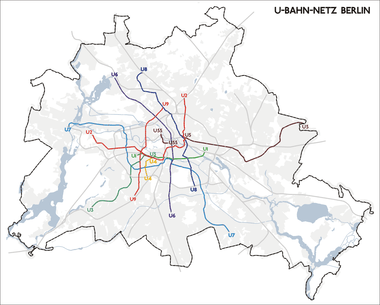
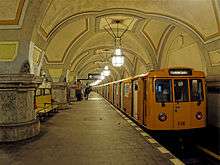
The Berlin U-Bahn (commonly understood to be short for Untergrundbahn - "underground railway") is a network of ten lines across the city. They are numbered from 1 to 9 with the prefix "U" ( U1 U2 U3 U4 U5 U6 U7 U8 U9 ), with the additional line U55 ( U55 ) in operation until its route gets connected to the U5 sometime 2020. You may find the U-Bahn network slightly less logical and convenient to use than in other European capitals, as Berlin's troubled history made its mark on it and many key locations remain unconnected, which is why using buses, trams and S-Bahn to complement the U-Bahn is probably necessary for efficient travel throughout Berlin. However as those systems are fully integrated (see above), you can do so with only one ticket or type of ticket. Generally speaking in the east trams are more widespread while the west relies more heavily on U-Bahn, but that has been slowly changing since 1990.
Despite the name "underground", some 20% of the network is actually made up of overground stretches running over characteristic viaducts throughout the city, adding a certain flavour to Berlin's cityscape. This arrangement is similar to many older subway systems which include elevated or even at-grade sections like the Hamburg system or the M2 / M6 lines in Paris. Unlike light rail systems or the Berlin tram however, all parts of the network have their own right of way and subways don't have level crossings.
Detailed maps can be found in every U-Bahn station and on the trains. U-Bahn stations can be seen from far by their big, friendly blue U signs. Together with the S-Bahn (which is administered by Deutsche Bahn and mostly runs aboveground), the U-Bahn provides a transportation network throughout greater Berlin that is extremely efficient and fast. On weekends (Friday to Sunday), and during the Christmas and New Year holidays, all U-Bahn and S-Bahn lines (except line U4 and U55) run all night, so returning from late night outings is easy, especially given the average start time of most 'parties' in Berlin (23:00 to 01:00). During the week there is no U-Bahn or S-Bahn service from c. 01:00-04:30, but metro trams/buses and special Night Buses (parallel to the U-Bahn line) run every half an hour 12:30-04:30.
There are no turnstiles to limit access to U-Bahn stations: it is technically possible to ride without a ticket. But if caught by a ticket checker you will be fined €60 (see "Validating tickets" above) so it is not only illegal but probably not worth the risk to ride without validating your ticket. Nearly all U- and S-Bahn stations now have electronic signs that display the expected arrival of the next train (and its direction), based on sensors along the lines.
Design-wise, U-Bahn stations are about as diverse as you'd expect for a system that started operations when the Kaiser reigned and has been expanded in phases of overflowing as well as empty municipal coffers. Quite a handful of stations built before World War II were designed by the Swedish architect Alfred Grenander (died 1931) whose designs are much lauded and who included some useful features like having each station dominated by a certain color which - where it is still visible to the untrained eye - helps in quickly recognizing a station. From the mid 1960s to mid 1990s most stations built in West Berlin were designed by Rainer G. Rümmler (1929-2004) who gave each station a much more individual look compared to Grenander who preferred to vary only small details like the color of the tiles. There are of course other stations, designed by other architects and for the new U5 extension station "Museumsinsel" a rather grandiose design has been chosen that will surely impress visitors when the station opens.
By tram (streetcar)
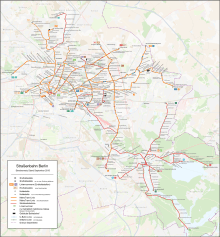
The trams (Straßenbahn) are mostly found in East Berlin, as the West Berlin tram network was shut down in the 1960s in an effort to make the city more car friendly. If you don't already have a ticket, you can buy one inside the tram. Since reunification there has been a gradual "reconquista" of areas once served by trams in West-Berlin and in some parts of Mitte it is hard to tell from trams alone where the wall used to be. In outlying districts of West Berlin, however, trams are still nowhere to be found - in stark contrast to the East, where they provide much needed access to planned bedroom communities from East German times. The red-red-green coalition sworn in in 2016 has stated a firm commitment towards more trams and there are plans to expand and improve the network before the end of the parliamentary term in 2021.
There are two types of tram. Metrotrams usually have a 24/7 schedule as well as higher frequencies during daytimes, although stops are more spread out. Metrotrams are marked by an "M" in front of their line number (e.g., M10). "Regular" trams stop more frequently and even incorporate picturesque single-track rides through forested areas far east of the Mitte district.
Despite being called "tram" the network has almost all characteristics of light rail and new lines are always built with their own right of way, making travel times faster than by bus. Even compared to some other trams in other German cities, the newest generation of Berlin trams have impressive acceleration, so take care when boarding and try to get a seat or hold onto something, especially if you're not sure on your feet.
By bus
Berlin's buses are a very important form of public transportation, as they complement the light rail systems wherever they were removed (trams in the West) or remain incomplete. Due to the heavy loads and demands of narrow streets, Berlin is one of the few cities in Europe to use double-decker buses extensively - over 400 of the 1400 buses in operation in Berlin are double-deckers. A ride in a Berlin double-decker should be on the to-do list of every first-time visitor to Berlin. Unlike other world cities, you should not flag down buses at stops in Berlin, even if there are multiple routes serving the stop. Some drivers may consider it an insult to their professionalism. A frequent problem with buses, particularly busy lines during rush hour and especially in the West (where they have to cope with levels of patronage more common for light rail lines) is bunching. As many buses come every five minutes during busy times, the first bus will get most of the passengers, meaning the bus behind catches up, which means the second bus gets even less passengers catching up even more, until finally two or three buses come a minute apart or even at the same time and then no bus comes for 15 minutes despite a nominal 5 minute headway. BVG are rather self-deprecating about the issue but aside from building new tram lines there is very little that can be done about it. Boarding fast and getting away from the door area is the best you can do to mitigate the issue.
There are various types of buses in Berlin, each indicated separately on public transit maps:
- Metro buses are meant to replace the dismantled tram lines mostly within the western part of the city (although many run into East Berlin as well to replace the severed tram connections). They are designated using the letter "M" and two digits, and are considered a separate means of transportation from the other buses, being marked orange on signage and maps just like the trams are (the orange "M" logo means "MetroBus" or MetroTram). The MetroBuses tend to run along the main transportation corridors and are generally operated using the double-decker buses, which makes using them very attractive for tourists. MetroBuses generally run every 10 minutes from every stop they serve. Among the lines especially attractive for tourists are M19 and M29, which run along the Kurfürstendamm and the M41, which connects the districts of Kreuzberg and Neukölln to the main station via Potsdamer Platz.
- Express bus lines connect important locations, such as airports and train stations, in a very fast fashion by skipping many stops along the way. They run every 5 minutes in the city centre using double-decker buses or articulated buses. The express lines are designated with the letter "X" and one or two digits, except for the special airport line TXL connecting the Tegel Airport with the city centre. Other lines of interest to travellers may be the X9 from Tegel Airport to Zoologischer Garten and the X7 from Schönefeld Airport to U-Bahn U7.
- Regular bus lines have three-digit numbers and their digits each have a meaning that committed public transit buffs can decipher to find out the exact route the bus does. For the most part, those buses will be of use to travellers only if they want to get to a particular location not served by other means of transportation, including metro or express buses.
- Two exceptions are special sightseeing lines 100 and 200, which run from along some of the most important tourist attractions in the city centre and are operated using double-decker buses exclusively. The 100 runs from Zoologischer Garten to Alexanderplatz through the Tiergarten park, Regierungsviertel and Unter den Linden street. The 200 diverts from that route to visit the Kulturforum, Potsdamer Platz and extend further east from Alexanderplatz to Prenzlauer Berg. Either ride is a must for any visitor to Berlin. The Berlin Start-Up "City Pirates" offers a free audio guide for the bus 100 that automatically plays audio information about the sights along the route via GPS localization (German and English, Android und iOS). In the summer bus 218 takes you along the scenic ride through the Grunewald forest in West Berlin, starting at the subway station Theodor-Heuss-Platz (U2) and ending near the famous Pfaueninsel in South West Berlin, where you can take a small ferry to said island and visit the park and the small castle there.
- Night buses operate in the night when the other means of transportation do not.
- The single-digit lines replace the metro lines in the night when the latter do not operate, stopping at the stops right atop/beside the U-Bahn stations. The numbering follows the numbering of U-Bahn lines, but uses "N" instead of "U", so that N7 is a bus line replacing the U7 U-Bahn line.
- Other double-digit night lines (N10 through N97) cover other routes, but without straightforward reference to daytime route numbers
There is no difference in fares between different types of buses - even the MetroBuses, the 100 and 200 demand the same fares as regular buses. Therefore, riding the city buses is a very cost-effective way of exploring the city compared to the many privately-operated "hop-on/hop-off sightseeing bus tours".
By bicycle
- See also: Cycling#Germany
Berlin has no steep hills and offers many bicycle paths (Radwege) throughout the city (although not all are very smooth). These include 860 km of completely separate bike paths, 60 km of bike lanes on streets, 50 km of bike lanes on pavements or sidewalks, 100 km of mixed-use pedestrian-bike paths, and 70 km of combined bus-bike lanes on streets. Bicycles are a very popular method of transportation among Berlin residents, and there is almost always a certain level of bicycle traffic. The political debate in the 2010s has swung decisively in favour of cycling, with a city-wide plebiscite causing the reigning centre/left red-red-green coalition to sign into law an extensive programme in favour of more and better cycle infrastructure, which the initiators of the plebiscite have stated to monitor closely to ensure implementation.
Seeing Berlin by bicycle is unquestionably a great way to get acquainted with the big tourist sites, and the little sprees and side streets as well. The probably most famous bicycle path is the Mauerradweg, a bike path along the former Berlin wall. Although it's good to carry your own map, you can also always check your location at any U-Bahn station and many bus stations. You can create your own bicycling maps on-line, optimised by less busy routes or fewer traffic lights or your favourite paving.
Tours and rentals
Traditional rental places are widespread, especially in areas frequented by tourists. Have a look around or ask at your accommodation. Most places have a rental charge of between €8 and €12 per day – they are excellent value and give you the freedom to explore the big city.
If you are not familiar with searching your own way through the city or you want more explanation of the sights you visit, you can get guided bike tours (with bike included) on Baja Bikes or Berlin Bike.
Berlin also has a bike sharing programme, LIDL-BIKE (formerly Call a Bike) making bikes available all over the town to pick up and leave anywhere you like. The bikes are grey/green and can be found across the central districts of Berlin. Follow the instructions on the bike touchscreen or use the mobile app. Rentals cost, basic annual fee of €3, then €1 for each 30 minute up to a maximum of €15 a day. You may however prefer to pay the monthly fee of €9 or a yearly fee of €49 and get the first 30 minutes of each rental for free, even right after returning your previous bike.
Bicycles on public transport
You can take your bicycle on any S- and U-Bahn, trains and trams using the designated areas. Ferries usually have space for bike but can get crowded during peak times and good weather. Buses do not take bikes with the exception of night buses N1-N9 on the nights between Sunday and Monday, and Thursday and Friday (that's when there is no night service of the U-Bahn). These buses have space for one bike. Bike space on any mode of public transport is limited and you might be refused entry. Wheelchairs and buggies have priority over bikes.
You need to purchase a ticket for your bike as well. The prices are as follows:
- Single trip. Berlin AB €1.90, Berlin ABC €2.50.
- Day ticket. Berlin AB €4.80, Berlin ABC €5.40.
- Short trip (Kurzstrecke). Price: €1.20.
By taxi
Taxi services are easy to use and a bit less expensive than in many other big Central European cities. You can hail a cab (the yellow light on the top shows the cab is available), or find a taxi rank (Taxistand). Taxi drivers are in general able to speak English. If you ask for a short trip (Kurzstrecke), as long as it's under 2 km and before the taxi driver starts the meter running, the trip normally is cheaper, €4. This only applies if you flag the taxi down on the street, not if you get in at a taxi rank. Here there is a taxi price calculator for Berlin.
By ferry
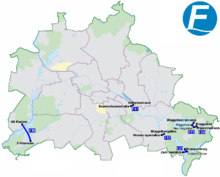
Despite not being a maritime city like Hamburg or Venice, Berlin does have usable waterways and the BVG run a couple of ferries, which can be accessed with regular BVG tickets. Most of the ferries are of local interest only, but the Ferry line F10 covers 4.4 km (2.7 mi) across the Wannsee and connects to the S-Bahn at one end. More of a tourist attraction than actual practical transportation is Ferry F24, which is the only ferry operated by a rowing boat in Berlin and the only rowing boat ferry that is part of any public transit ticketing system in Germany. In an effort to become a "greener" city some of the ferries run on electricity provided by solar panels on their roofs or land based charging stations.
In addition to those public transit ferries there are tour boats doing sight seeing trips mostly along the river Spree and mostly as circular tours. They are much more expensive than BVG tickets.
By gondola lift
In the course of the 2017 international gardening exhibition in Berlin/East, Berlin received its first gondola lift, which stayed in operation after the exhibition closed. It links to Kienberg (Gärten der Welt) U-Bahn station along U5 at one end and has all of three stations along a line length of 1,580 m (5,180 ft) which is comparable to U55. It is not part of BVG ticketing and at €6.50 per return trip, tickets are comparatively expensive.
See
- Individual listings can be found in Berlin's district articles
Berlin has numerous attractions dating from its turbulent history and in part owing to the fact that it was a "double capital" for 40 years. While the upkeep of some is an ongoing headache for the treasurer, they are a delight to visitors and many locals alike.
Museums
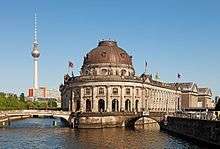
Berlin has a vast array of museums. By far most of them are covered in the Mitte district guide, which, among others, covers the 🌍 Museumsinsel (an island on the Spree covered with historic museums) and the 🌍 Kulturforum (a collection of contemporary cultural institutions). You will also find a good deal of museums in the West and Steglitz-Zehlendorf area of the city, but there are larger or smaller museums in almost every district. There are museums covering everything, from art through Berlin's and Germany's history to various branches of technology and science.
Most museums charge admission for people 18 years of age or older - usually €6 to €14. Discounts (usually 50%) are available for students and disabled people with identification. Children and young people can often come in free, but do check the age restrictions in particular museums. A nice offer for museum addicts is the three-day Museums Pass for €29 (concessions: €14.50), which grants entrance to all the regular exhibitions of the approximately 30 state-run museums and public foundations.
Most museums are closed on Mondays - notable exceptions include the Pergamon Museum, the Neues Museum and the Deutsches Historisches Museum, which are open daily. Museumsportal Berlin, a collective web initiative, offers easy access to information on all museums, memorials, castles and collections and on current and upcoming exhibitions. Some museums offer free or steeply discounted entry once a week, once a month or during certain hours of the day. This website has daily updates on free offers in Berlin.
Remains of the Berlin Wall
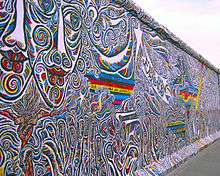
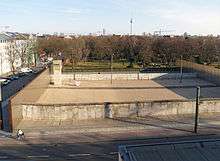
While the Berlin Wall has long been dismantled and much of the grounds it occupied completely redeveloped, you can still find parts of the wall preserved around Berlin. This does not refer to very small pieces of the Wall sold by the East German government immediately after its dismantling, which can be found in various cafes, restaurants and hotels not only in Berlin, but to actual preserved fragments of the Wall still standing in their original locations. For large parts of the distance the wall ran in central Berlin, pavement markers show its former location.
The iconic 🌍 Brandenburg Gate is right at the main street, Unter den Linden. One of the most often visited is the 🌍 Checkpoint Charlie at the southern border of Mitte and Kreuzberg, which is a recreated legendary border crossing within the Friedrichstraße. You cannot see the actual wall there, but this iconic (and extremely touristy) point is on almost every visitor's list. West from there, you can find a piece of the wall lining up the Niederkirchnerstraße next to the Topography of Terror museum in Kreuzberg. Another popular site is the East Side Gallery along the Spree in Friedrichshain, a very long stretch of preserved Wall with colorful graffiti. All of the aforementioned fragments were altered and are now tourist attractions rather than actual historic monuments - if you want a truly preserved section of the Wall, head over to the northern border of Mitte and Gesundbrunnen in the street Bernauer Straße and visit the 🌍 Berlin Wall Memorial, with a complete section of the wall in all its gloom. A smaller section of the original wall can be seen from the S-Bahn when travelling between Nordbahnhof and Humbolthain stations.
A 160 km (99 mi) biking and walking trail along the former Berlin Wall, the Berliner Mauerweg (Berlin Wall Trail), is well sign-posted and provides alternating sections of historic importance and natural beauty.
Private art galleries
As Berlin is a city of art, it is quite easy to find an art gallery on your way. They provide a nice opportunity to have a look at modern artists' work in a not-so-crowded environment for free. Some gallery streets with more than about a dozen galleries are Auguststraße, Linienstraße, Torstraße, Brunnenstraße (all Mitte, north of S-Bahn station Oranienburger Straße), Zimmerstraße (Kreuzberg, U-Bahn station Kochstraße) and Fasanenstraße (Charlottenburg). You can find a list of all the exhibitions and gallery openings as well as a map on Berlin Art Grid.
Tall buildings with observation decks
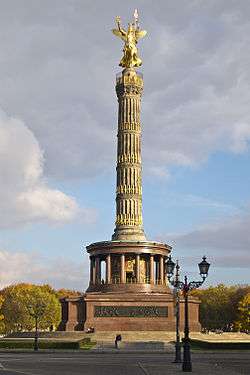
Berlin has its fair share of tall buildings and, as the city is quite expansive and does not have one single centre where all tall buildings are located, you can enjoy a nice view from most of them, even ones that are not tall by global standards.
Most of the viewing points are spread out within the Berlin/Mitte district. Germany's tallest construction, the 🌍 Fernsehturm (TV Tower), located on Alexanderplatz, is 368 m tall and the observation deck with bar and restaurant is at around 205 m. Nearby, you can find the Park Inn Hotel with a small terrace on the 40th floor. From there you have great views of the Fernsehturm. Another viewing point in a modern building at 101 m is the Kollhoff Tower at Potsdamer Platz, which also features the fastest elevator in Europe.
One of the three most important historic buildings with viewing points is the Reichstagsgebäude, the building that is home to the German Parliament in Spreebogen / Regierungsviertel), with a spectacular glass dome, that offers a great view of Berlin. The entry to the dome is free, but you need to book your ticket in advance. The famous 67 m tall monument 🌍 Siegessäule (Victory Column), once directly in front of the Reichstagsgebäude, but now located in the middle of the Straße des 17. Juni in Tiergarten, has a viewing platform. You can also climb on top of the Berliner Dom (Berlin Cathedral) in Berlin/Mitte on the Museumsinsel for a view of the city.
The viewing point that is located in a different district is the Funkturm (Radio Tower) in Westend. It is a 150 m tall lattice tower with open-air observation deck 124 m above ground.
The only free viewing point is the one on the Reichstagsgebäude, the others range between €3-13.
Zoo
Berlin has two zoos and an aquarium. The 🌍 Berlin Zoo in the west (Berlin/Mitte) is the historic zoo. It's an oasis in the city and very popular with families and schools. It has the largest range of species in the world and is famous for its pandas. The Aquarium Berlin is the largest aquarium in Germany and part of the Berlin Zoo (can be visited separately). It is near the Elephant Gate (Budapester Straße), one of the entrances to the zoo, and a traditional photo stop for most visitors because of the architecture. The Tierpark Berlin in Friedrichsfelde (Berlin/East) is more spacious than the historic Berlin Zoo and has been open for some 50 years, dating to the era of partition when authorities in the East wanted to offer their people their own zoo. The compound also includes a small château with its adjacent park.
Do
- Individual listings can be found in Berlin's district articles
Pick up a copy of Exberliner, the monthly English-language paper for Berlin to find out what's on, when and where. It provides high quality journalism and up-to-date listings. If you understand German, the activity planners for the city, zitty and tip, are available at every kiosk. Be prepared to choose among a huge number of options.
Explore
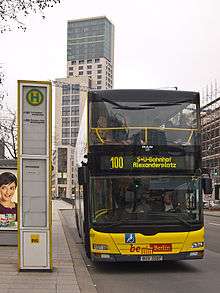
.jpg)
Go on a tour of Berlin. The Mitte and surrounding districts are sufficiently compact to allow a number of excellent walking tours through its history-filled streets. You'll see amazing things you would otherwise miss. Details are usually available from the reception desks of hostels and hotels.
- 🌍 Berlin Tour by public bus line 100 and 200. The 100 and 200 bus lines are just ordinary bus lines, but they pass by many of Berlin's famous landmarks. Both run every 5–10 minutes between S+U-station Zoologischer Garten and S+U-station Alexanderplatz. All BVG tickets are accepted. €2.70 (single) or €7.60 (day ticket).
- Ticket B. Showing the city of Berlin on hand-picked architectural routes. Led by architects in German, English, French, Italian or Spanish. Tours from the water, on land or in a helicopter are offered. They arrange your special tour on contemporary architecture in Berlin with many exclusive visits to the interiors of buildings.
- Stern und Kreisschiffahrt. By far the biggest boat company in Berlin. They offer tours on most lakes.
- Yachtcharter Werder. Offers the possibility of a long term stay on the waterways of Berlin and the surrounding federal state Brandenburg.
- Segway Tour Berlin. 3. Offers different Segway Sightseeing Tours in Berlin. Start near Brandenburger Tor, for small groups up to 10 people. 75 EUR.
Outdoor recreation
Berlin has many great parks which are very popular in the summer. Green Berlin operates some of them.
Berlin's largest park is Großer Tiergarten (in Berlin/Mitte). In the summer and on weekends you will see loads of families with their barbecues.
There are a few notable parks in Berlin/East Central. Superb panoramic views across south Berlin can be had in Viktoriapark in Kreuzberg. You'll also find a National monument by Schinkel on top of it. Mauerpark is famous the Bearpit Karaoke taking place every second Sunday in summer, and for the large flea market. It's also a popular barbecuing spot. Görlitzer Park has barbecue area, a football ground and a minigolf company.
Adjacent to Charlottenburg Palace in Berlin/City West is Schlossgarten Charlottenburg. The green areas of the park are free, so you can go there to have a walk even if you are not interested in the palace.
A bit further afield with subway access in Berlin/East are the Gärten der Welt (World's Garden). Inside you can find a large, well-established Chinese garden, a Korean garden, a small Bali's Garden/Glasshouse, an Oriental Garden with nice fountains and a cloister and a Japanese garden which is a project by the city partnership of Berlin and Tokyo. Best time for a visit is in spring or summer. A bit further afield in the opposite direction, in Berlin/Steglitz-Zehlendorf, is the Botanischer Garten und Botanisches Museum Berlin-Dahlem (Botanical Garden and Botanical Museum Berlin-Dahlem).
The large Treptower Park in Berlin/Treptow-Köpenick next to the Spree is nice and clean. It's famous for the Insel der Jugend (Isle of Youth) and its numerous boat rentals and boat trips.
Berlin also has quite a few lakes and beaches suitable for swimming. They quite often have one paid area with facilities, and frequent unmanaged places with free access. Some have designated areas for nude bathing (FKK). Wannsee in Berlin/Steglitz-Zehlendorf is called Berlin's "bath tub". The Strandbad Wannsee is the most famous bathing area for locals. Take the S-Bahn lines S1 or S7 to the station Nikolassee and follow the crowd! In the southeast of Berlin in Berlin/Treptow-Köpenick, you'll find the Müggelsee which is a popular swimming spot.
Festivals and annual events

- Ultraschall Berlin - Festival für neue Musik. In January. An annual festival begun in 1999 that is dedicated to new music featuring both world premieres and music by recent composers. Concerts take place in different venues across the city and are performed by small ensembles up to big orchestras.
- Berlinale – Berlin Film Festival. In February. The city's largest cultural event and an important fixture in the global film industry's calendar (up there with Cannes). 250,000 tickets sold, 400 different films screened and a host of associated parties and events every year. In contrast to Cannes, all screenings at the Berlinale are open to the public. Tickets are inexpensive and relatively easy to get for the "International Forum of Young Film" screenings and the "Berlinale Panorama" (movies which are not in the competition).
- MaerzMusik. In March. A festival with contemporary music and performances on issues of our time, organised by Berliner Festspiele.
- 🌍 Open Air Gallery Oberbaumbrücke, Oberbaumbrücke between Kreuzberg and Friedrichshain (in Berlin/East Central, just under the bridge Oberbaum). June: 10:00-22:00. Artists are selling their works, amateur tango dancers are giving public performances and you can contribute to a collaborative painting on a very long canvas spread on the street along the festival. Free.
- Fête de la Musique (Worldwide Music Day). June 21 every year. All kinds of music around the city on this day coordinating with a similar day in most French cities.
- Young Euro Classic. In August. A music festival established in 2000 that features youth orchestras from around the world. The concerts take place in the Konzerthaus Berlin on Gendarmenmarkt. The festival usually runs for around 2 weeks. Concerts often feature world premieres.
- Lange Nacht der Museen (Long Night of Museums), ☎ +49 30 24749888. End of August. A large cultural event with many museums (around 80) open until 02:00 and extra events around the city. Adults €18, concessions €12, under 12 free. Ticket includes unlimited use of the shuttle bus service and public transportation (BVG and S-Bahn). If you buy in advance the tickets are cheaper.
- Doors Open Day of the Federal Government (Tag der offenen Tür der Bundesregierung). Last weekend in August. For one weekend, the federal government organises doors open days where most of the Federal Ministries and other governmental institutions can be accessed. Parts of the German Chancellery are also accessible, where the current chancellor will usually show up. Free transport between the locations is provided. There are security checks and they advise to avoid bringing larger objects (such as suitcases). Bring an official ID with you. Free.
- Musikfest Berlin. End of August. A large classical music festival marking the beginning of the season. For about 2 weeks there are concerts in many of Berlin's music venues. Renowned international and German orchestras perform. Organised by Berliner Festspiele.
- Festival of Lights, ☎ +49 30 25489244. In October. A 10-day long festival, where famous buildings in Berlin are illuminated in a special way. Free.
Parades
- Karneval. In late February or early March. As a lot of people in Berlin originally came from the southern or western area of Germany where Fasching, Fastnacht or Karneval is celebrated, a carnival parade was also established in Berlin. It grew bigger and bigger (about 500,000 to 1 million people watching), but the costumes and cars are rather boring and the people are not as dressed up as in the "original" big carnival parades (Cologne, Mainz, Düsseldorf). Since 2007 the traditional route across Kurfürstendamm was chosen. People from Berlin themselves don't care a bit about Karneval; this is mostly an event for people coming from the regions of Germany that have a Karneval. In fact, most Berliners will be laughing at you if you mention that you went to Karneval, so beware that this is not a Berlin tradition, but a recent (post-1990) institution.
- Karneval der Kulturen (Carnival of Cultures). In May or June (on Whit Sunday). The idea of the "Carnival of Cultures" is a parade of the various ethnic groups of the city showing traditional music, costumes and dances. Other more modern, alternative and political groups also participate. Similar events are also held in Hamburg and Frankfurt.
- Christopher Street Day. Late July. Berlin's gay pride. A well-known annual political demonstration for the rights of the gay culture organised in all major German cities. Even if you are indifferent about the issue, the Christopher Street Day is usually a worthwhile sight as many participants show up in wild costumes.
- Fuckparade. In August. The Fuckparade (Hateparade in the early days) started as an antiparade or demonstration against the commercialised Love Parade, and was first on the same date as the Love Parade but later the date was shifted. The Fuckparade is a political demonstration, with political speeches at the beginning and the end and the parade with music between. The general motto of the Fuckparade is "against the destruction of the club scene". The music is quite different than at the Love Parade: mostly independent/alternative/extreme electronic music.
- Hanf Parade. In August. The Hanfparade is the biggest European political demonstration for the legalization of hemp for use in agriculture and as a stimulant. Conflicts with police have been known to occur and consuming any form of Cannabis at this demonstration is not a good idea as the police will control people if only to show that they can.
Cultural venues
_-_clone.jpg)
Berlin is arguably the live cultural centre of Germany. A comprehensive platform that lists cultural events is offered by Berlin Bühnen on behalf of about 80 venues.
Theatre
- 🌍 Deutsches Theater (German Theatre) (in Berlin/Mitte). Classical theatre with an impressive line up of actors and directors.
- 🌍 Berliner Ensemble (Theater am Schiffbauer Damm) (in Berlin/Mitte). Contemporary theatre.
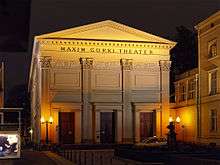
- 🌍 Maxim Gorki Theater (in Berlin/Mitte).
- 🌍 Volksbühne am Rosa Luxemburg Platz (People's Theatre) (in Berlin/Mitte). Sometimes controversial, modern theatre.
- 🌍 Schaubühne am Lehniner Platz (in Berlin/City West). Modern theatre.
- 🌍 Theater am Kurfürstendamm (in Berlin/City West). Popular theatre with TV celebrities in modern plays.
- 🌍 English Theatre Berlin (in Berlin/East Central). Theatre that features all plays and music theatre in English.
Musicals and shows
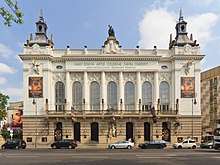
- 🌍 Theater des Westens (Theatre of the West) (in Berlin/City West). A historic theatre in the former West Berlin, only musicals today.
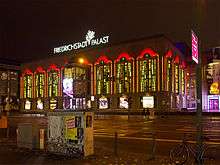
- 🌍 Theater am Potsdamer Platz (in Berlin/Mitte). Musicaltheater.
- 🌍 Friedrichstadt-Palast (in Berlin/Mitte). Berlin's biggest show with over 100 artists on the biggest theatre stage in the world.
Opera
- 🌍 Komische Oper Berlin (in Berlin/Mitte). Modern operas.
- 🌍 Deutsche Oper (in Berlin/City West). Classic opera house of West Berlin.
- 🌍 Staatsoper Unter den Linden (in Berlin/Mitte). The impressive building and royal history make the building alone worth a visit.
- 🌍 Schiller Theater (in Berlin/City West).
- 🌍 Neuköllner Oper (in Berlin/Tempelhof and Neukölln). Voted several times best off-opera house and known for its modern and contemporary pieces. Mostly in German as usually relating to developments in Germany. Very creative and innovative.
Concerts
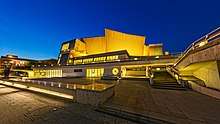

- 🌍 Berliner Philharmonie (in Berlin/Mitte). A large concert hall designed by Hans Scharoun and home of the Berlin Philharmonic Orchestra. Famous building and outstanding musicians. Reservations are recommended, but cheaper tickets are usually available 2–4 hr before the concert if not sold out. Every Tuesday (September to June) 13:00-14:00 free lunch concert; come early. In the winter, late-night concerts (22:30 or 23:00) are a bargain and often have more avant-garde or unconventional formats. The adjacent Kammermusiksaal (Chamber Music Hall) was added later and hosts smaller concerts.
- 🌍 Konzerthaus Berlin (in Berlin/Mitte).
- Hochschule für Musik Hanns Eisler (HfM) (in Berlin/Mitte). The HfM (Berlin Academy of Music) offers many concerts by their students and other professional musicians, most of them are free.
Cinema
There are about a hundred cinemas in Berlin, although most of them only show movies dubbed in German, without subtitles. Listed below are some of the more important cinemas also showing movies in the original language (look for the OmU - "original with subtitles" - notation). Most movies which are dubbed into German are released a bit later in Germany. Tickets are normally €5-7. Monday to Wednesday are special cinema days with reduced admission.
There are three notable cinemas in Kreuzberg in Berlin/East Central within close proximity. Babylon Kreuzberg, a small cinema built in the 1950s, which shows non-mainstream movies. Kino Moviemento which is the oldest cinema in Germany (1907). And Eiszeit. In Berlin/Mitte near Hackesche Höfe there is Kino Central, a repertory cinema located in an ex-squat, and Filmtheater Hackesche Höfe showing a very broad range of movies. Kant Kino in Berlin/City West is one of the few old cinemas (founded 1912) left in Berlin's western city. It shows mostly non-mainstream European movies.
The mainstream cinema, CineStar Original, shows only movies in original version (e.g. in English, without subtitles); and CineStar IMAX is a 3D cinema with special laser and sound technology. IMAX films are usually available in English. Both cinemas are located in the Sony Center at Potsdamer Platz in Berlin/Mitte.
Sport
In Berlin, nearly all sports are on offer; some speculate that the lukewarm support Hertha enjoys even in times of success is due to the huge offer of other sports (similar to how Los Angeles failed to maintain an NFL team due to the diverse cultural offerings):
- The most popular sport is association football (soccer), which is played all over the city. The Berlin FA lists all the clubs.
- Not to be missed is the Olympic Stadium, which hosted the 2006 world cup final and the infamous 1936 Olympics. Hertha BSC Berlin, Berlin’s highest professional soccer team, plays there during the Bundesliga season in spring, fall and winter.
- Berlin Handball has had a hard time competing with the north German powerhouses but these days the Füchse Berlin from Reinickendorf who play their home games in Max Schmeling Halle are a force to be reckoned with.
- 🌍 Basketball. Alba Berlin, known as The Albatross are consistently the best basketball team in Germany, and one of the best in Europe. With fans crazier than most in the NBA, Albatross games at the o2 World arena are an exciting way to take in one of the world's greatest sports.
- Public swimming pools. Can be found around the city. Check out BBB for pool listings and opening times.
- Sailing, on one of the many lakes is also popular. You can find sailing clubs and most universities have ships as well.
- Golf. You can find golf clubs all around Berlin, although for non-members Motzen has one of the best.
- 🌍 Ice hockey. The Berlin Eisbären (Polar Bears) play this fast, exciting and very physical sport during the winter. The excitement is heightened by the singing and chanting of the crowds, who are fueled by the copious quantities of wurst and beer available.
- Floorball, is booming faster than ever before in the German capital. A sum of teams defines the cascade of the local floorball scene, whereas the decorated Bundesliga site of BAT Berlin probably embodies the most prominent one.
- American Football. After the closing of NFL Europe and the related end of Berlin Thunder (triple winner of the World Bowl), the Berlin Adler (Eagles) have historically been Berlin’s No. 1 team playing in the German Football League (until 2017) they are one of the oldest and most storied teams in Germany being a founding member of the first American Football season in 1979 but have entered something of a slump, often falling to their crosstown rivals. Apart from the "Berlin-Derby" a highlight of the season is the match against the Dresden Monarchs as the two teams share an intense and storied rivalry. The Berlin Rebels (in 2018) have somewhat overtaken them in on-field success playing in the first division German Football League. The 2017 season saw the Adler lose the promotion/relegation round against a team from Potsdam so 2018 will see the Rebels and Potsdam but no Adler in the GFL1. American Football in Germany is a very relaxed and family friendly affair and you can definitely show up in any NFL, German or no Football gear at all and have a chat with fans of either side.
- 🌍 Australian Football. The Berlin Crocodiles host regular matches in the summer.
Learn
|
Universities in Berlin Berlin has three major universities, and one art university. Freie Universität was founded after World War II in West Berlin and today the city's largest university by number of students. Its name (literally "Free University") refers to the ideological conflict during the Cold War. Humboldt Universität is the oldest university in Berlin with an impressive record of alumni and professors – Albert Einstein, G.W.F. Hegel, Karl Marx and Friedrich Engels, to name but a few. During the Cold War it was the main university in East Berlin and after reunification there have been efforts to reinstate its former glory. The Technische Universität was founded in 1879 as Technische Hochschule Berlin with a good reputation for its research. The Universität der Künste Berlin is one of the largest institutions of music and arts in the world. This institution was for the most time of its existence called Hochschule der Künste, and you can still find the abbreviation HDK in the logo on some buildings. |
The German capital naturally has some good options for learning the language:
- 🌍 Goethe-Institut Berlin, Neue Schönhauser Str. 20, ☎ +49 30 259063, e-mail: berlin@goethe.de. Learn the German language with a variety of courses of different durations. Certificates from this institute are globally recognised as the standard for German language ability.
Work
The current economic climate is stable but to find work in Berlin is not easy. A sound level of German improves your chance as only few multinational companies are present in Berlin. Any kind of skills (especially language) that separates you from the masses will definitely improve your chances for a job. Berlin has a lower GDP per capita than the German average, but slowly but surely new startups founded in Berlin are becoming bigger and bigger players and some companies have decided to open representative headquarters in Berlin following reunification - most notably Siemens, a company founded and intimately linked with Berlin that had most of its production and even de facto headquarters in Erlangen and Munich during partition but is to reoccupy "Siemensstadt" (a part of Berlin/Spandau) with a railway line built in the 1920s to serve Siemens to be reactivated.
If you have an academic background then teaching English (Spanish, French & Latin are good, too) or private tutoring (e.g. math) for pupils is always a possibility as Berlin is a young city and education is in strong demand. Otherwise working in a bar might be an option but it'll be tough, because wages are low and big tips are uncommon. Chances are much better when big trade fairs (e.g. "Grüne Woche", bread & butter or ITB) or conventions take place so apply at temp & trade fair agencies. The hospitality industry and call centres are constantly hiring but wages are very low unless you can offer special skills (such as exotic languages) or background.
Berlin has a growing media, modelling and TV/movie industry. For daily soaps, telenovelas and movies most companies look for people with something specific. Apply at the bigger casting and acting agencies.
For English-language jobs, if might be worth checking out the classified ads of this monthly magazine for English-speakers, Exberliner.
Buy
- Individual listings can be found in Berlin's district articles
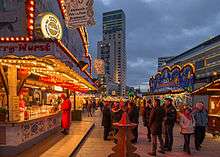
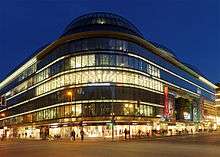
Orientation
The main shopping areas are:
- Ku'Damm and its extension Tauentzienstraße in Berlin/City West remain the main shopping streets even now that the Wall has come down. KaDeWe (Kaufhaus des Westens) at Wittenbergplatz is a must visit just for the vast food department on the 6th floor. It's reputedly the biggest department store in Continental Europe and still has an old world charm, with very helpful and friendly staff.
- Schloßstraße in Steglitz (Berlin/Steglitz-Zehlendorf) with the shopping centre Schloss-Straßen-Center, Forum Steglitz, Karstadt, Boulevard Berlin, Naturkaufhaus and Das Schloss, between the subway stations U9 Walther-Schreiber-Platz and U9+S1 Rathaus Steglitz.
- Friedrichstraße in Berlin/Mitte is the upmarket shopping street in former East Berlin with Galeries Lafayette and the other Quartiers (204 to 207) as main areas to be impressed with wealthy shoppers.
- Alexanderplatz in Berlin/Mitte. The renovated Galeria Kaufhof department store is worth a visit. For alternative souvenirs go to ausberlin.
The main shopping area for the alternative, but still wealthy crowd is north of Hackescher Markt in Berlin/Mitte, especially around the Hackesche Höfe.
For some more affordable but still very fashionable shopping there is Prenzlauer Berg, Kreuzberg and Friedrichshain in Berlin/East Central with a lot of young designers opening shops, but also lots of record stores and design shops. Constant change makes it hard to recommend a place, but the area around station Eberswalder Straße in Prenzlauer Berg, around Bergmannstraße and Oranienstraße in Kreuzberg and around Boxhagener Platz in Friedrichshain are always great when it comes to shopping.
For souvenirs, have a look just in front of the Kaiser Wilhelm Gedächtniskirche (Berlin/City West); these shops sell almost the same items as others, but are cheaper. However, not all members of staff speak English. You can also get cheap postcards there (from €0.30 while the average price for normal postcard is €0.50-0.80).
Markets
There are four market halls selling fresh produce and ready-to-eat food. Marheinecke Markthalle and Markthalle Neun are both in Kreuzberg (Berlin/East Central), Arminiusmarkthalle is in Moabit (Berlin/City West), and Markthalle Tegel is in Tegel (Berlin/Reinickendorf and Spandau).
You can find dozens of flea markets with different themes in Berlin (mostly on weekends), but worth checking out is the big one at Straße des 17. Juni (between Ernst-Reuter-Haus and S-Bahn: Tiergarten). Two other flea markets are at Mauerpark in Prenzlauer Berg (Berlin/East Central) and at Arkonaplatz (Berlin/Mitte), which is close to Mauerpark. Both are on Sundays, so you can combine visiting them.
Opening hours
Shopping hours are theoretically unlimited on weekdays. Nevertheless, many of the smaller shops still close at 20:00. Most of the bigger stores and nearly all of the malls are open until 21:00 or 22:00 from Thursday to Saturday.
Sunday opening is still limited to about a dozen weekends per year, although some supermarkets in train stations (Hauptbahnhof, Bahnhof Zoologischer Garten (under the S-Bahn bridge), Friedrichstraße, Innsbrucker Platz (U4 in the underground) and Ostbahnhof) are open on Sundays.
Many bakeries and small food stores (called Spätkauf or colloquially "Späti") are open late at night and on Sundays in more gentrified neighbourhoods (especially Prenzlauer Berg, Kreuzberg and Friedrichshain). Stores inside the Hauptbahnhof (central station) have long working hours (usually until about 22:00-23:00), also on Sundays.
Credit cards
Credit cards are becoming more common, but Germans still largely prefer cash, as well EC/Maestro cards. Most places in tourist zones will accept credit cards, but it is still a good idea to ask in advance if you intend to pay with one. Many restaurants require a minimum check amount, sometimes in excess of €30.
For Americans, Germany uses the chip-and-pin system so you may have trouble at places like unattended gas stations and automated ticket machines. Often, a cashier will be able to swipe the magnetic strip, but don't be surprised if someone refuses your credit card because it doesn't have a chip.
Eat
- Individual listings can be found in Berlin's district articles
|
Ich bin ein Berliner in some parts of Germany - but not Berlin, jelly doughnuts are known as Berliner, but in Berlin, they're called Pfannkuchen. This in turn means "pancake" almost everywhere else, so if you want a pancake in Berlin, you have to ask for Eierkuchen. Confused yet? |
Lovers of street food rejoice! Berlin has an incredibly wide variety of different styles and tastes at very affordable prices (for European wallets, that is). You can find superb food in small stalls tucked away under the tracks of elevated U-Bahn stretches for well under five euros.
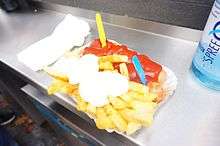
A staple in Berlin is currywurst. It's a bratwurst covered in ketchup and curry powder. You can find them all over Berlin by street vendors. It's a must try when in Berlin. Two renowned currywurst stands are "Konnopke's Imbiss" below Eberswalder Straße U-Bahn station on line 2 and "Curry 36" opposite the Mehringdamm U-Bahn station in Kreuzberg (only two stops south of Checkpoint Charlie). Both of these offer far friendlier service than many of Berlin's more upmarket eateries.
Another famous thing to eat in Berlin is döner, a flat bread filled with lamb or chicken meat and vegetables, available at many Turkish stands.
Berlin may seem like carnivore heaven, but vegetarians and vegans can eat quite well. Berliners are generally environmentally conscious, and that extends to their food; most of the inner neighbourhoods have a handful of good healthy vegetarian or vegan restaurants using local ingredients, though they tend to be more expensive than the ubiquitous kebab and sausage stands. If you're a vegetarian on a limited budget, many kebab restaurants have a good selection of roasted vegetables and salads, and you can usually get falafels (fried chickpea balls, suitable for vegans) and halloumi (a type of dense cheese) in place of meat.
Eating out in Berlin is incredibly inexpensive compared to any other Western European capital or other German cities. The city is multicultural and many cultures' cuisines are represented here somewhere, although they are often modified to suit German tastes.
All prices must include VAT by law. Only upmarket restaurants may ask for a further service surcharge. It is best to ask if credit cards are accepted before you sit down—it's not that common to accept credit cards and cash is preferred. Most likely to be accepted are Visa and MasterCard; all other cards will only be accepted in some upmarket restaurants. European debit cards are not always accepted because due to debit card fraud, some processing companies stopped intra-European cards from specific countries. This does not apply to debit cards that are from German banks. Better have cash or ask the restaurant staff.
Orientation
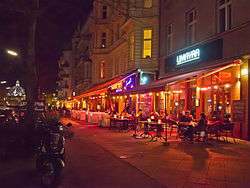
One of the main tourist areas for eating out is Hackescher Markt/Oranienburger Straße. This area has dramatically changed during the years: once full of squats and not-entirely-legal bars and restaurants, it had some real character. It is rapidly being developed and corporatised, and even the most famous squat - the former Jewish-owned proto-shopping mall "Tacheles" - has had a bit of a facelift. There are still some gems in the side streets, though, The "Assel" (Woodlouse) on Oranienburger Straße, furnished with DDR-era furniture, is still relatively authentic and worth a visit, especially on a warm summer night. Oranienburger Straße is also an area where prostitutes line up at night, but don't be put off by this. The area is actually very safe since several administrative and religious buildings are located here.
For cheap and good food (especially from Turkey and the Middle East) you should try Kreuzberg and Neukölln with their abundance of Indian, pizza and Döner Kebap restaurants. Prices start from €2 for a kebab or Turkish pizza (different from the original Italian recipe and ingredients). If you are looking for a quick meal you could try getting off at Görlitzer Bahnhof or Schlesisches Tor on the U1 line - the area is filled with inexpensive, quality restaurants.
Kastanienallee is a good choice too - but again not what it used to be since the developers moved in (much less exploited than Hackescher Markt, though). It's a popular area with artists and students and has a certain Bohemian charm. Try Imbiss W, at the corner of Zionskirchstraße and Kastanienallee, where they serve superb Indian fusion food, mostly vegetarian, at the hands of artist-chef Gordon W. Further. Up the street is the Prater Garten, Berlin's oldest beer garden and an excellent place in the summer.
All restaurant information is in the corresponding borough articles of
- Kreuzberg & Friedrichshain – Young and independent student area with a big Turkish community in Kreuzberg, slowly but surely gentrifying.
- City West – Heart of West Berlin with good quality restaurants.
- Mitte – Political and new centre of East Berlin with upmarket restaurants.
- Schöneberg – City slickers and street cafe atmosphere.
- Prenzlauer Berg – Buzzing Prenzlberg and its lively student scene.
Waiters and tipping
Except at very high-end restaurants, nobody will seat you. If you see an open table, just sit down. You may need to go get a menu yourself from another table or a pile near the cash register. If you sit outside, expect slightly slower service.
As in most European countries, you need to tell the waiter when you want to pay and leave. The waiter will come to you usually with a money purse, and the custom in Germany is to tell the waiter how much you’re paying (including the tip) when you receive the bill — don’t leave the money on the table. If there is confusion with the tip, remember to ask for your change, Wechselgeld (money back).
Add a 5-10% tip (or round up to the next Euro) to the bill if you are satisfied with the service. If you received shoddy service or are otherwise unsatisfied it is perfectly acceptable to not tip at all - waiters and waitresses have the same €8.85 an hour minimum wage any other job has, so they don't depend on tips as the biggest part of their salary like in the US.
Breakfast
It is very common to go out for breakfast or brunch (long breakfast and lunch, all you can eat buffet, usually from 10:00-16:00, for €4-12 - sometimes including coffee, tea or juice). See the district pages of Berlin/City West#Breakfast & Berlin/East Central#Eat.
Drink
- Individual listings can be found in Berlin's district articles
Clubs
The club scene in Berlin is one of the biggest and most progressive in Europe. Even though there are some 200 clubs in the city, it's sometimes difficult to find the right club for you since the best ones are a bit off the beaten track and most bouncers will keep bigger tourist groups (especially males) out. If you want to go clubbing, you will almost always have to pay an entrance fee. However, entrance is cheap compared to other big European cities, normally €5-15 (usually no drink included).
The main clubbing districts are in the east: Mitte (especially north of Hackescher Markt and - a bit hidden - around Alexanderplatz), Friedrichshain-Kreuzberg (around Schlesisches Tor) and Prenzlauer Berg (around station Eberswalder Str.). Some mainstream clubs are located in Charlottenburg and at Potsdamer Platz. Electro and techno are still the biggest in Berlin, with lots of progressive DJs and live acts around. But there are also many clubs playing '60s beat, alternative rock and of course mainstream music. Clubbing days are Thursday, Friday and especially Saturday, but some clubs are open every day of the week. Partying in Berlin starts around midnight (weekends) and peaks around 2AM or 3AM in the normal clubs, a bit later in many electro/techno clubs. Berlin is famous for its long and decadent after hours, going on until Monday evening.
A good overview about what's going on close to the place you are staying is brought to you by joinjack.de. This website shows you parties directly on a map. Be sure to check Resident Advisor for the best parties before you go out.
Bars
Berliners -especially young Berliners- love cocktails. People like to meet their friends at a cocktail bar before going clubbing. Prenzlauer Berg (Around U-Bahnhof Eberswalder Str., Helmholtzplatz, Oderberger Straße & Kastanienallee), Kreuzberg (Bergmannstraße, Oranienstraße and the area around Görlitzer Park and U-Bahnhof Schlesisches Tor), Schöneberg (Goltzstraße, Nollendorfplatz, Motzstraße for gays), and Friedrichshain (Simon-Dach-Straße and around Boxhagener Platz) are the main areas.
Some bars charge a small refundable deposit for glasses - you are given a token with your drink to return (with your glass) to the bar.
At Warschauer Straße (which you can reach via S-Bahn and U-Bahn station Warschauer Straße) and more specifically Simon-Dach-Straße and around Boxhagener Platz you can find a wide variety of bars. It is common for locals to meet at Warschauer to go to a bar there. Also Ostkreuz ("Eastcross") and Frankfurter Allee are well known meeting points. Especially to visit the alternative ("underground-/left-szene") locations in houseprojects (so called squats), like the Supamolly at Jessnerstreet (Traveplatz), the Scharni38 (Scharnweberstreet) and so on, or famous alternative clubs on the Revaler Straße, like the R.A.W. or the Lovelite on Simplonstraße.
There are lots of Irish bars all over the city, as there are in all European cities. If you like off-the-shelf Irish bars or watching football in English then you won't be disappointed, but in a city with new cool bars opening pretty much daily and a huge range from which to choose, you'll find that these cater mostly to the Irish construction workers and Germans attracted by Irish music, which is often played in them. The Irish pub in the Europa Center at Tauentzienstraße is famous. Located in the basement of a skyscraper, you will find a big Irish pub and a rowdy crowd on the weekend. It also claims to have the longest bar in all of Berlin!
There aren't as many illegal bars as there were in the 1990s but bars open and close faster than you can keep up - check out the bar and cocktail guides in the bi-weekly magazines Tip or Zitty. For recommended bars, have a look at the district pages.
Concerts
There are well over 1000 rock concerts a year in Berlin. You can find concerts in the big known locations but there are also many interesting little venues. You can find a good overview of the current concerts on the Ma Baker concert page. Every day the concerts are updated and displayed there.
Brauhäuser
A Brauhaus (brewery) brews and sells its own beer on the premises. There is usually a public viewing area onto the brewery. Try Gaffel Haus, Brauhaus Georgbraeu, Brauhaus Mitte, Brauhaus Spandau and Brauhaus Lemke.
Cafes
Cafe Einstein is one particular example of a home grown coffee chain which has nice staff, great coffee and is fairly priced. In particular, the Einstein on Unter den Linden is as far from "junk coffee" as it's possible to be.
If you want to get some tap water, ask for "Leitungswasser" (if you just say "water" (Wasser), you will receive mineral water.) This is common if you drink coffee. They should not charge you for it but you should order another drink as well.
Street drinking
Kiosks (off licences) can be found all over the city and sell bottled beers and other drinks. A kiosk will generally have a bottle opener on the counter and it is permitted to drink alcohol in the street. A refundable deposit of 8 to 25 cents per container (Pfand) is charged on plastic and glass bottles.
Sleep
- Individual listings can be found in Berlin's district articles
Berlin is still witnessing a construction boom of hotels and offices since the end of the Cold War. The boom leads to a significant oversupply of hotels which results in comparatively cheap prices even in the 5 star category (off-season prices of €110 per night are not unusual). Especially for a short visit, it may be best to stay at a place in Berlin-Mitte (around Friedrichstraße), as most of the main sights are located there. Due to its history most hotels in Berlin are still located in the City West (i.e. Charlottenburg-Wilmersdorf), especially close to Zoo station. Alexanderplatz and Anhalter Bahnhof have clusters of 2-3 star budget hotels (i.e. Ibis, Motel One). You'll find only budget hotels (Motel One and Meininger) located directly at the new main train station but some large constructions are in progress. The (oddly named) budget hotel chain 'Motel-One' operates various 2-star hotels in the city centre. There are also many 3-4 star 'NH Hotels' offering good value. All major hotel chains are present in Berlin. A good idea to check that the hotel is close to public transport (U-Bahn or S-Bahn) to avoid too long walks.
Cheapest are youth hostels (called Jugendherbergen, only for members) and hostels (similar to youth hostels, but for everyone, mostly backpackers stay here, usually in one to 32-bed rooms). You will also find bed and breakfast offers (often private) and boarding houses (Pension, more familiar and smaller than hotels). Be aware that the majority of private flats on platforms like AirBnB are offered illegaly in Berlin and contribute to the ongoing housing crisis. Try to choose your accommodation responsibly!
Check the district pages for individual accommodation listings. Popular hotel districts include:
- Mitte - mostly high-end hotels in the main tourist areas and some cheap hotels and hostels on the outskirts
- Charlottenburg-Wilmersdorf - the largest number of mid-range and upscale hotels can be found here, mostly grouped around the Zoologischer Garten railway station and the Ku'damm
- Prenzlauer Berg - here you will find many independent small hotels, hostels and guesthouses in the relaxed atmosphere of this district
- Friedrichshain-Kreuzberg - the centre of alternative life in Berlin offers many suitably-themed accommodation opportunities, mostly hostels and guesthouses
You may find accommodation at reasonable prices in almost any district of Berlin, but be mindful of the time it may take to get from that place to where you want to visit, as Berlin is a very large city.
Connect
You can find internet cafes and telephone shops all around Berlin. Do a bit of research with the telephone shops because most focus on a particular region in the world. Many bars, restaurants and cafes offer their guests free wi-fi. Customers of the ubiquitous Einstein Coffee get 30 minutes of free wifi. Metro (U-Bahn) stations offer free wi-fi to everybody: BVG Wi-Fi.
The mobile network (3G/GPRS/GSM) covers the whole city. If you are coming from a non-GSM country (e.g. the United States) check your mobile phone for GSM compatibility. The GSM iPhone, which works with AT&T and T-Mobile in the U.S., works perfectly in Berlin.
A free wireless network covers parts of Berlin, but requires special software on your computer. More information including maps of Berlin with coverage is available online.
Stay safe
Berlin is a safe place but it has some not-so-well maintained areas, too. No specific rules apply with the exception of public transportation and tourist areas where pickpockets are a problem. Watch your bags during rush hours and at larger train stations.
The police in Berlin are competent, not corrupt; therefore, if you try to bribe them you are likely to spend at least a night behind bars to check your background. They are generally helpful to tourists. Most of the officers are able to speak English, so don't hesitate to approach them if you are frightened or lost. Police are generally more relaxed than in more conservative places like Munich and do not necessarily engage in a "zero tolerance" policy (but even then blatantly smoking a joint in front of police will land you in trouble even in Berlin). In general police will focus on crime and traffic safety rather than petty misdemeanors or drunken tourists unless things get out of hand.
The nationwide emergency numbers are
- Medical emergencies and Fires, ☎ 112.
- Police emergency number, ☎ 110.
Since the 1980s, there have been localised riots on Labour Day (May 1). In general they take place in Kreuzberg around Oranienstraße/Mariannenplatz. Nowadays they usually start the night before May 1, especially in the Mauerpark (Prenzlauer Berg), at Boxhagener Platz and in Rigaer Str. (Friedrichshain) and start again in the evening of May 1 in Kreuzberg and in the mentioned areas. The violent riots have become rather small since 2005 due to the engagement of the citizens who celebrate the Labour Day with a nice "myfest" in Kreuzberg and well-planned police efforts. It is still better to stay out of these areas from 20:00 until sunrise. Vehicles should not be parked in these area as this is asking for damage!
Racially-motivated violence is rare but the risk is higher on the outskirts of East Berlin. It is recommended for non-Caucasian tourists to be attentive in areas such as Lichtenberg, Hellersdorf, Marzahn, Treptow and Köpenick in the evening/night especially if alone.
In the bordering neighbourhood of the districts Neukölln and Kreuzberg (between Hermannplatz, Schönleinstraße to Kottbusser Tor) and Wedding (Moabit and Gesundbrunnen) the risk of falling victim to robberies and assaults is slightly higher. Tourists should visit these areas with some caution during the night as a mixture of drunken party people and poor neighbourhoods might lead to trouble.
National media and conservative politicians like to make a huge story out of certain well known drug dealing hot spots. Areas such as Görlitzer Park are well known for all sorts of illicit substances being on offer, but if you don't sell or buy this shouldn't preoccupy you. Despite media portrayals to the contrary, police do frequently raid those places and try to catch drug dealers, but only a small handful are usually caught as they have developed certain measures to evade capture. Organized criminality does exist, but in general they try to focus on less violent activity in Germany and hardly ever target outsiders.
Although harmless, panhandlers have started to beg at local tourist spots such as Pariser Platz next to the Brandenburg Gate, Alexanderplatz and the Museuminsel. They are usually women accompanied by their daughters who ask if you speak English and say that they are from the new EU countries and trying to raise money to fly home. The story is false, so don't give them money, which would encourage further exploitation of the women and their kids. They also have a new tactic where they hand you a card telling their "story" and asking for money; beware that the children that they carry in their arms will search through your bags while you are reading the card. The best way to avoid this is simply to ignore them and not to respond when they ask you "Speak English?" If you feel scared, don't hesitate to contact the police, as they will help.
Prostitution
Prostitution is a legal business in Germany. Berlin has no major red-light district though some big brothels have been built. Berlin has no restricted areas for prostitutes (called a "Sperrbezirk" in German) so the "apartments" or brothels are spread throughout the whole city. Oranienburger Straße in Mitte is infamous for its prostitutes at night. These women are a tourist attraction and the ladies focus only on tourists to request exorbitant prices.
The proximity to Eastern Europe, relaxed visa rules, and the illegal migrant community increases the number of prostitutes. Advertisements are in the tabloids and online. Human trafficking and illegal immigration is a problem; therefore, police raids do take place and close down illegal operations. Brothels and prostitutes must register just like any onther businesses, or they will be prosecuted for tax evasion. In general, police officers are not interested in the clients (especially if you stay calm and don't try to argue) but you must have a photo ID (a photocopy of your passport is fine) with you. Otherwise, you might spend a night at the police station while your background gets checked.
Stay healthy
Berlin is home to Charité, perhaps one of the world's most famous hospitals, former workplace of medicine legends like Robert Koch, Rudolf Virchow, Emil von Behring or Emil Fischer.
Cope
Libraries
Berlin has a large number of public libraries throughout the city. One of the largest is the Amerika-Gedenkbibliothek (America Memorial Library) on Blücherplatz 1.
Embassies
|
|
Go next
Some people from Berlin would ask you why you would ever want to leave, but there are a couple of nice places in close proximity - some even within reach of the Berlin S-Bahn. Brandenburg is mostly rural so a short drive will get you "away from it all" and right into picturesque nature.
The motorway Raststätte Grunewald at the S-Bahn station Nikolassee is a good spot for hitching if you're heading south or west.
- Potsdam — the capital of the surrounding federal state of Brandenburg, not far southwest of Berlin, and makes a perfect day trip. Especially the park of Sanssouci, a world heritage site with its great famous palaces, is worth a visit. You can get there with the S-Bahn S7 or Regional-Express RE1 to the station Potsdam Hauptbahnhof or Park Sanssouci (fare zone C). It takes about half an hour from Berlin Hauptbahnhof or Friedrichstraße.
- Oranienburg — a quiet suburb housing the remains of one of the few preserved Nazi concentration camps, KZ Sachsenhausen, on German soil. There's also a small palace in the centre of Oranienburg.
- Müritz Lake Region (Mecklenburgische Seenplatte) — a national park to the north with a few hundred lakes.
- Dresden — two hours away to the south. Intense competition on the Dresden-Berlin route means a bus ticket (2.5 to 3 hours) can be had for as little as five Euros.
- Leipzig — one and a quarter hours away by train to the south.
- The beautiful Baltic seashore (e.g. Usedom, Stralsund and Rügen) is close enough for a day trip by train.
- Spreewald — a protected UNESCO biosphere reserve. It includes low-lying areas in which the river Spree meanders in thousands of small waterways through meadows and forests. It is a beautiful, unique landscape about one hour south of Berlin and well worth a day trip or a weekend trip to relax from the buzzing city life.
- Frankfurt an der Oder — on the Polish border is within easy reach.
- Lutherstadt Wittenberg — about 40 minutes southeast of Berlin by ICE. Schlosskirche was the church where Martin Luther nailed his theses to the church door. Across the street from there is a visitor's centre with great information. Great city to tour and one can easily explore on foot.
- Hamburg — the second-largest city in Germany, is less than 2 hours away by ICE; the IRE takes a bit longer (3 hr) but the special offer of €19.90 one way (available at all times) is hard to beat and it's still faster than the bus.
- Munich is only four to four and a half hours away by train and in many ways the polar opposite of Berlin - where Berlin is alternative, poor and at times charmingly chaotic, Munich is conservative orderly and blessed with the pork barrel spending of the Bavarian government
The Polish border is just some 90 km to the east of Berlin, therefore it might be interesting to do a trip:
- Szczecin (Stettin) — about two and a half hours by train.
- Poznań (Posen) — three hours by train.
- Wroclaw (Breslau) — only 3-4 hours by car.
| Routes through Berlin |
| Hamburg ← | Hamburg |
→ Lutherstadt Wittenberg → Leipzig |
| Halle ← | Frankfurt |
→ END |